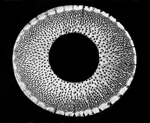
「修行尺八」歴史的証拠の研究 ホームページ
'Shugyō Shakuhachi' rekishi-teki shōko no kenkyū hōmupēji - zen-shakuhachi.dk
The "Ascetic Shakuhachi" Historical Evidence Research Web Pages
Introduction & Guide to the Documentation & Critical Study of Ascetic, Non-Dualistic Shakuhachi Culture, East & West:
Historical Chronology, Philology, Etymology, Vocabulary, Terminology, Concepts, Ideology, Iconology & Practices
By Torsten Mukuteki Olafsson •
トーステン
無穴笛
オーラフソン •
デンマーク • Denmark
|
Historical Shakuhachi Images 2 - from just before 1640 till the Present:Historical Shakuhachi Images Part 1 - till around 1640: A Pictorial Chronology of Known Fine Historical Illustrations of so called 'Shakuhachi' Flutes, Its Many Players Throughout The Times, with Additional Shakuhachi History Related Images
Mid-1600s' Early 'Komusō'?:
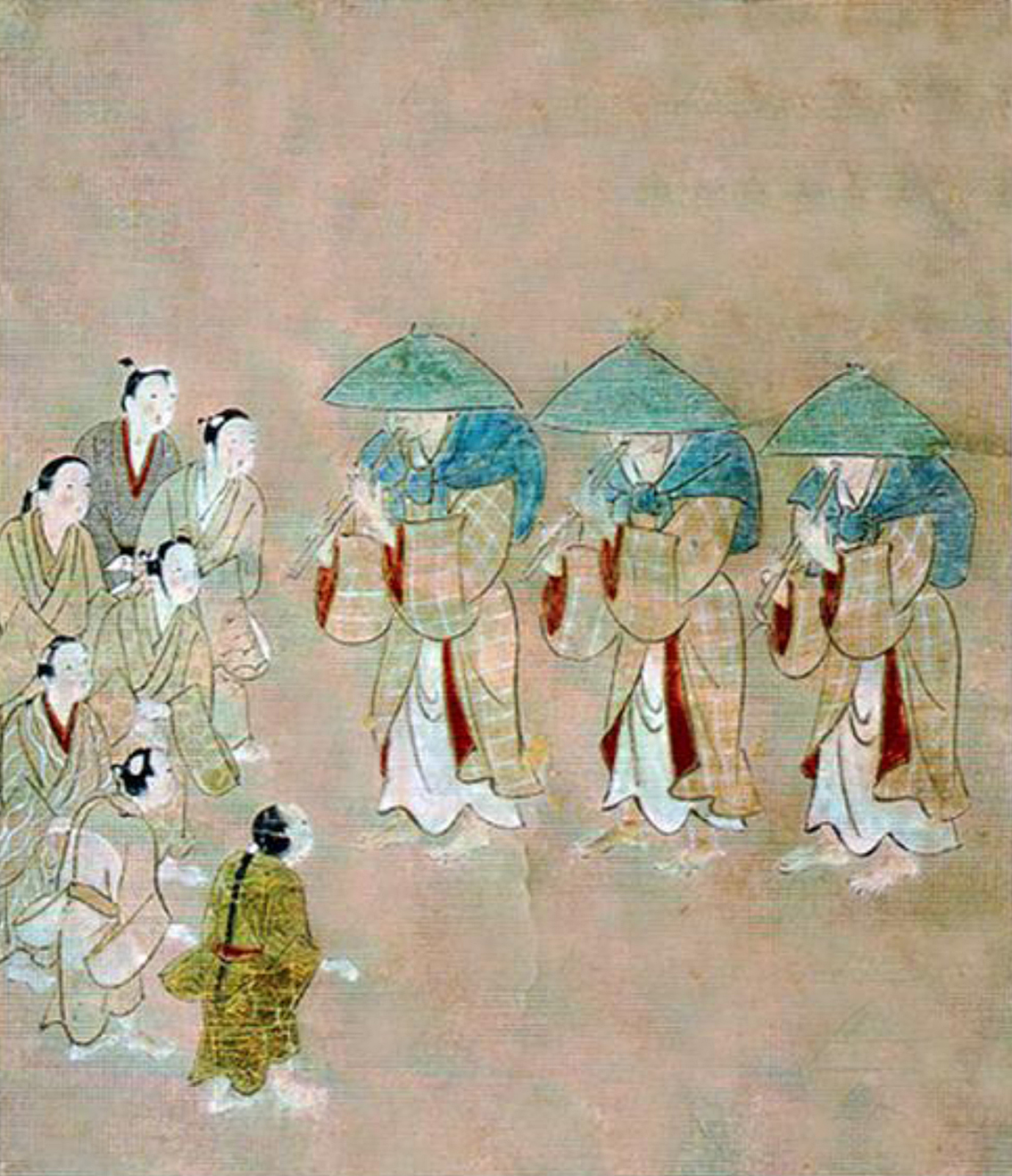
Painting of three early 'Komusō'. Possibly painted by Iwasa Matabei.
虚無僧 - KOMUSŌ
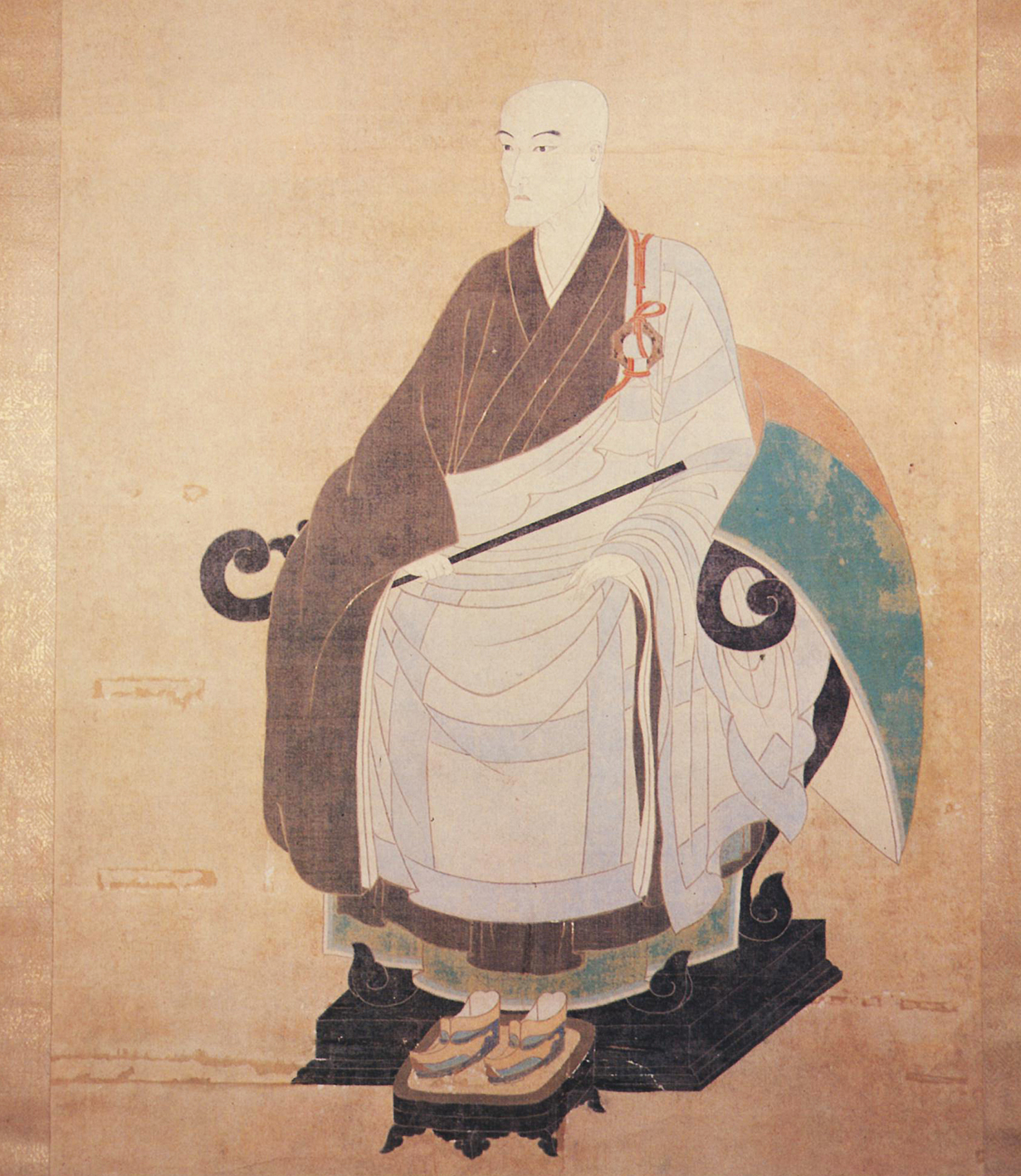
Isshi Bunshu, 一絲和尚, a most renowned Rinzai Zen abbot whose master was the great Rinzai Zen master Takuan Sōhō (1573-1645), lived from 1608 to 1645 (or 1646). Portrait preserved at the temple Hōjō-ji in Kameoka City, Kyōto Prefecture. A letter from Abbot Isshi to a certain hermit named Sandō Mugetsu Anjū, 山堂無月庵主, presumably written shortly before Isshi's death in 1645/1646, possibly presents the oldest known, surviving mention of the term 'Komusō', 虚無僧, "Pseudo-monk of the Non-Dual & None-ness". Here is a carefully retouched scanning of a xerox copy of the original hand-scroll, supplied to me in April, 1985, by the Kōkoku Temple in Yura, Wakayama.
Go to this webpage to study a translation of Abbot Isshi's letter til Sandō Mugetsu: Isshi Bunshu's Komu Shizen & 'Komusō' Letter |
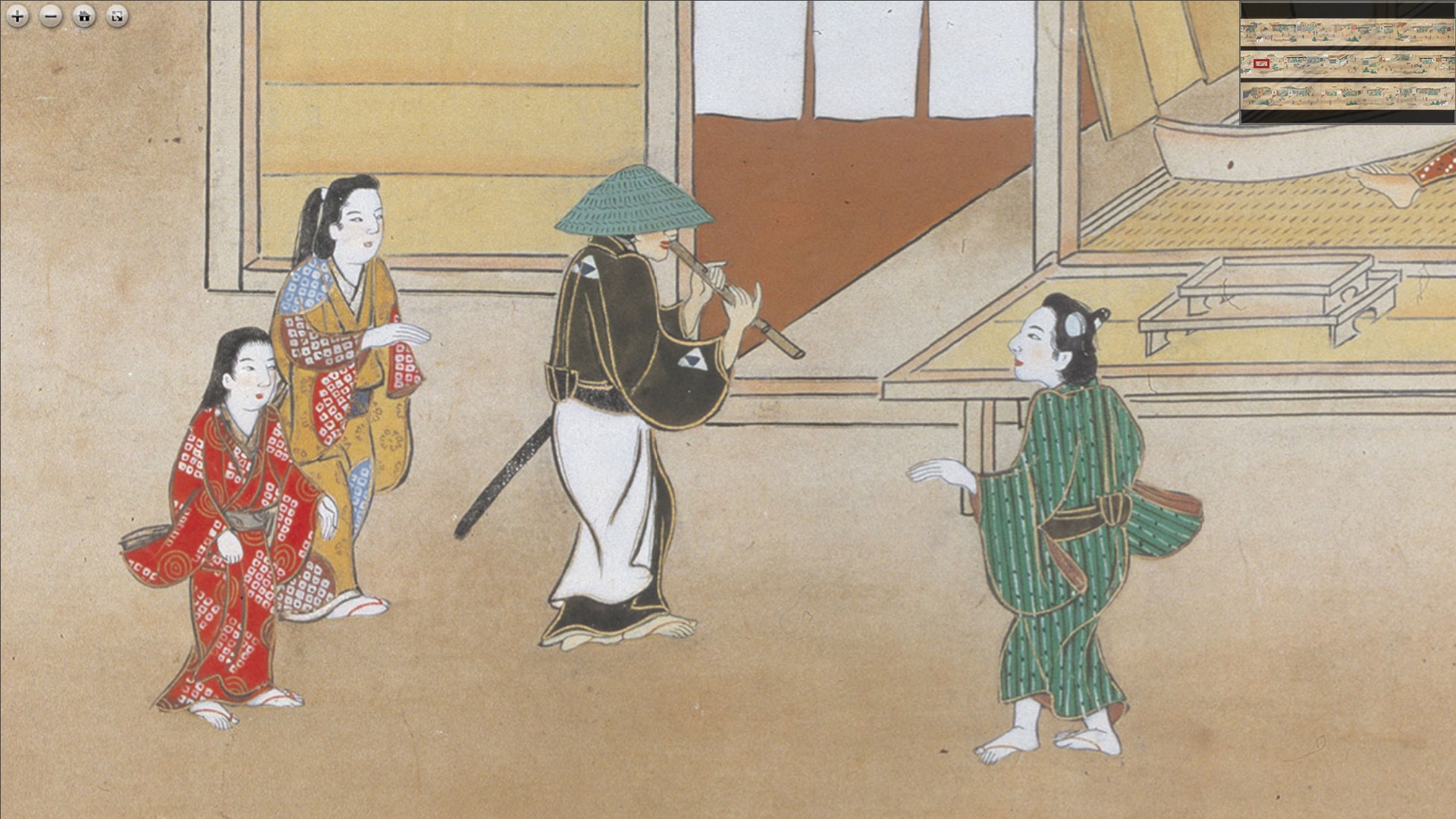
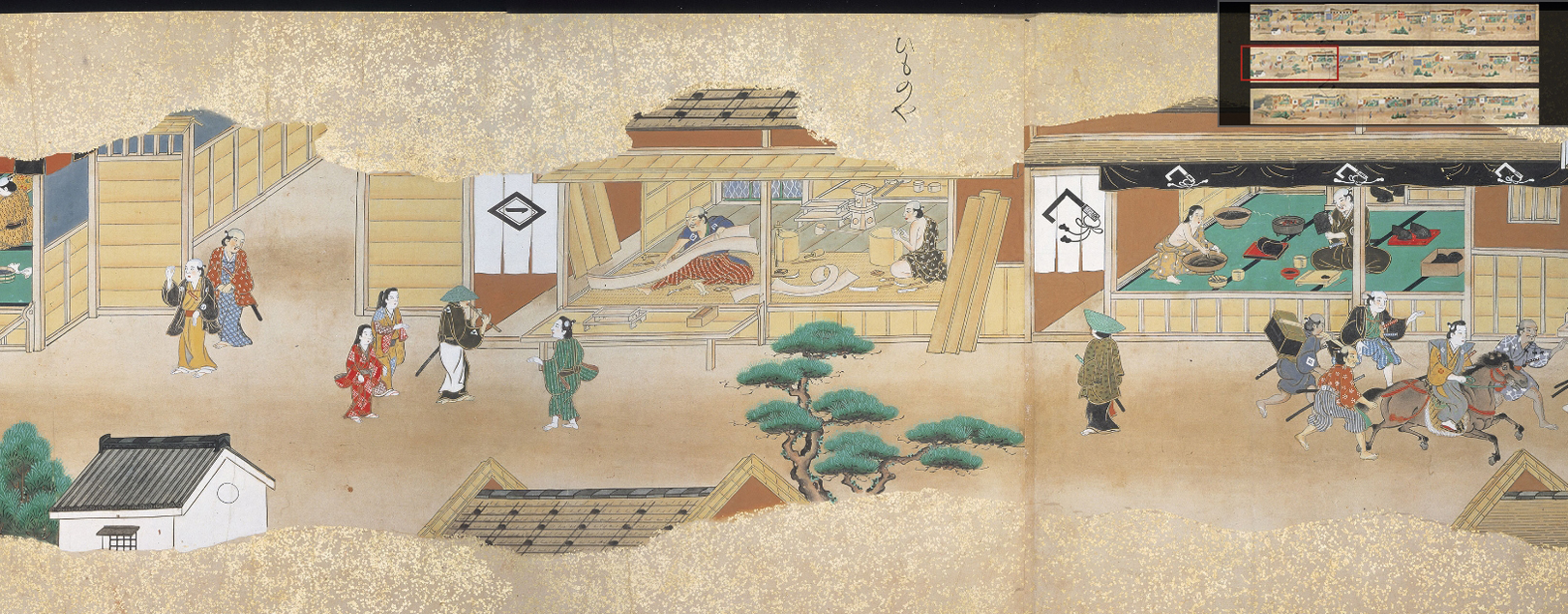

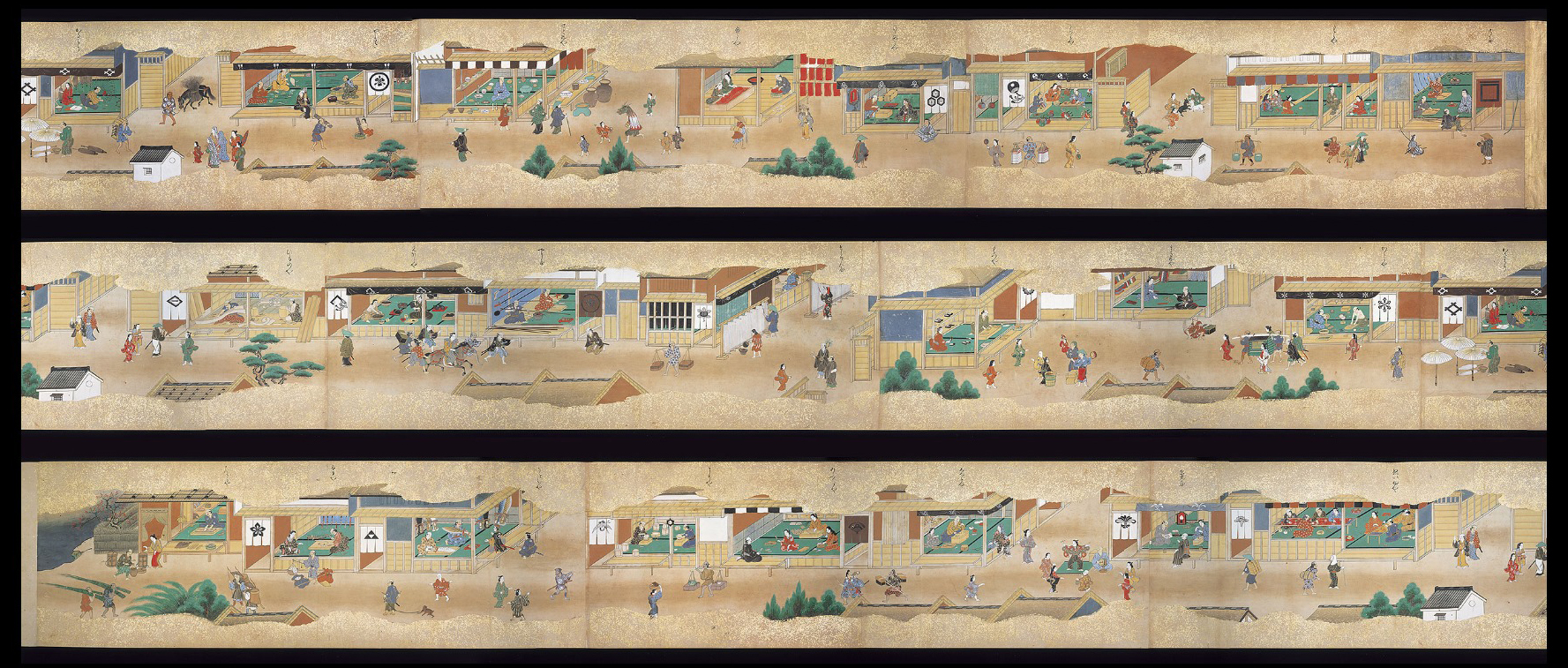
Samurai look-a-like flute player featured in the picture scroll
'Shokunin fūzoku emaki', "Picture scroll of Professions and Manners".
Artist unnamed. Dating still in some dispute. The scroll may be a mid-18th Edo Period work,
but the sword-carrying - though quite more samurai-looking - flute player certainly matches
the however few pictorial 'komosō' appearances that we know of
from only the first early decades of the 17th century.
Link to more information at The National Museum of Japanese History:
https://www.rekihaku.ac.jp/education_research/gallery/webgallery/shokunin_f/shokunin_f.html
And, acc. to that museum's art researcher Kojima Michihiro here:
https://twitter.com/ko_0021/status/1395715775936172040/photo/2
English lanugage page about the 'Shokunin fūzoku emaki' picture scroll: https://www.rekihaku.ac.jp/english/outline/publication/rekihaku/164/witness.html
Presented - and dated "1650" - online by Shakuhachi-Kataha, link to web page:
https://note.com/kataha_comjo/n/nb964ee048e6c
1650s?:
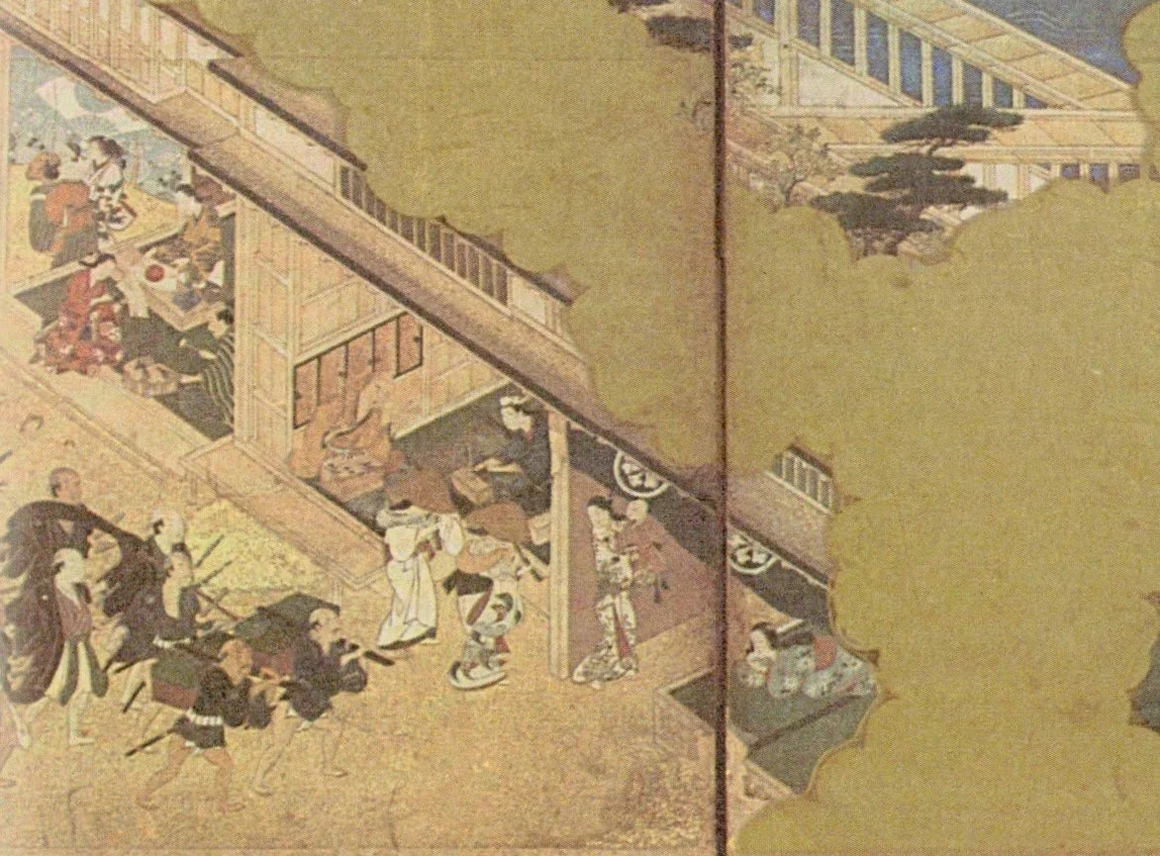
Two 'komusō' in 'Edo fūzoku-zu'. Scanned by Shakuhachi-Kataha
from an Idemitsu Museum of Arts book dating the art work as "1633-1657", it appears.
Presented online by Shakuhachi-Kataha, link to web page:
https://note.com/kataha_comjo/n/nb964ee048e6c
1658:
KYŌ WARABE by NAKAGAWA KIUN
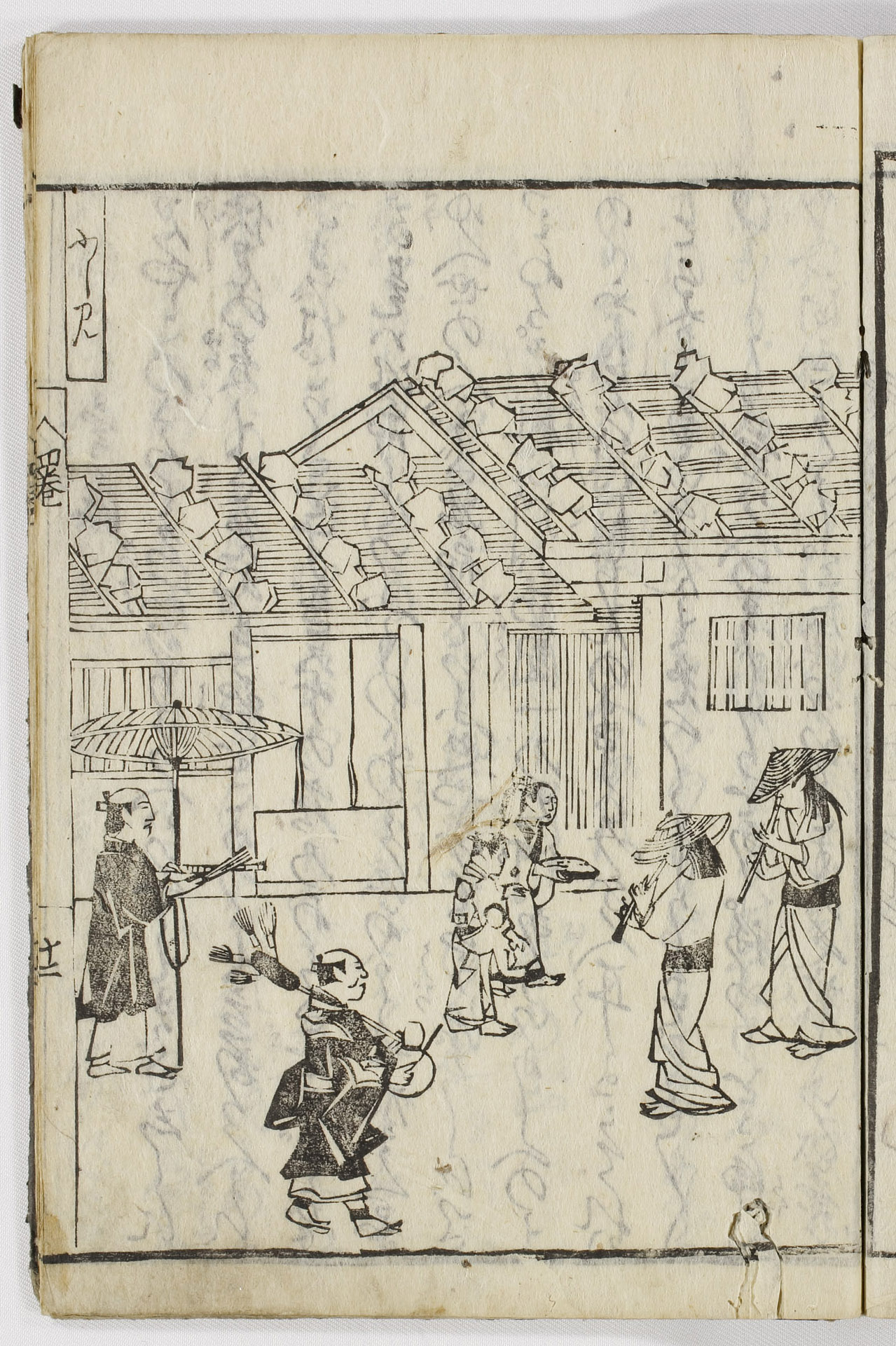
Two wandering vertical flute players in a Kyōto street
Possible very early Edo Period 'Komusō' -
"Lay Monks of the Non-Dual & None-ness"?
In: the 'Kyō warabe' by Nakagawa Kiun
The Remembering the Capital Archive, Kyōto
Source URL: Frame 13 in Volume 4 of the 'Kyō warabe'.
Source: The Remembering the Capital Archive, Kyōto.
1661 or 1665/1666? - UKIYO MONOGATARI by ASAI RYŌI
浮世物語 - "Tales from the Floating World"
浅井了意 - ASAI RYŌI - c. 1612-1691
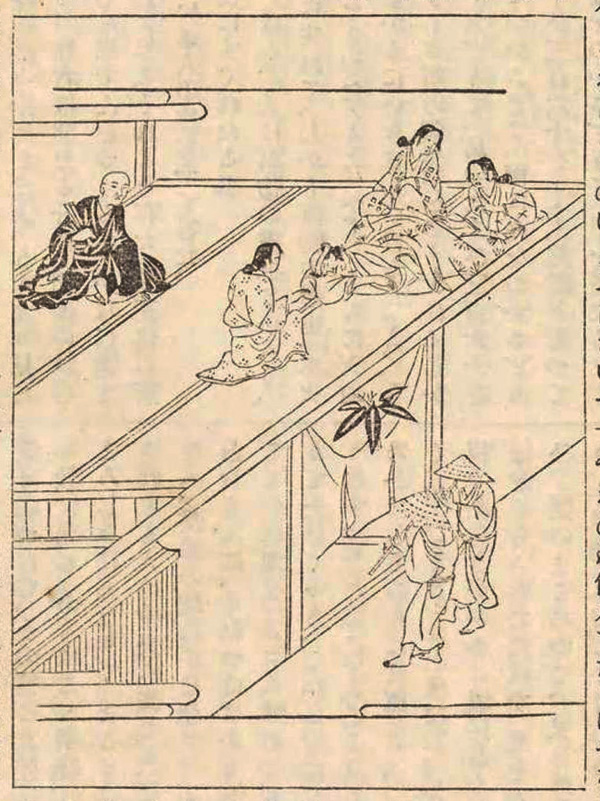
Here you see a genuine, original picture of possibly two 1660s, very early 'Komusō' that are featured
in the short story collection 'Ukiyo monogatari', "Tales of the Floating World", by Asai Ryōi.
This really rarely shown illustration was reprinted/reproduced in 1916 in a very comprehensive 12 volume collection of selected masterpieces of Japanese Tokugawa Period literature,
the 'Tokugawa bungei ruiju', Volume 2.
The short story with that particular unique picture attached does not at all mention any neither 'komo-sō',
nor 'komu-sō', so the two flute playing persons could only have been placed in the illustration to create
some sort of an authentic 'cosy' atmosphere for the narrative.
As you can see - very contrary to several more recent really poor, misleading redrawn copies of the two figures - the flute being played in the front is both thin and quite long,
i.e. not at all a 'konjiku', 根竹 "root-end", type of 'shakuhachi'.
Source: National Diet Library, Tokyo.
1682:
職人尽倭画
SHOKUNIN TSUKUSHI WAGA
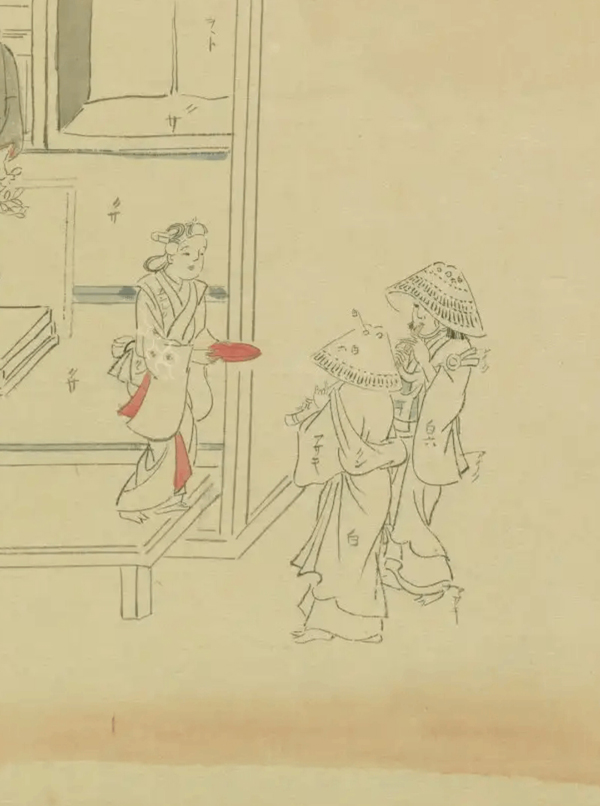
Two komusō receiving alms in the picture scroll 'Shokunin tsukushi waga'
by Hishikawa Moronobu, 1618-1694. National Diet Library Collection.
Published in 1856 by Tsukamoto Takehide.
Presented online by Shakuhachi-Kataha, link to web page:
https://note.com/kataha_comjo/n/nb964ee048e6c
Link to NDL: https://dl.ndl.go.jp/en/pid/2542563
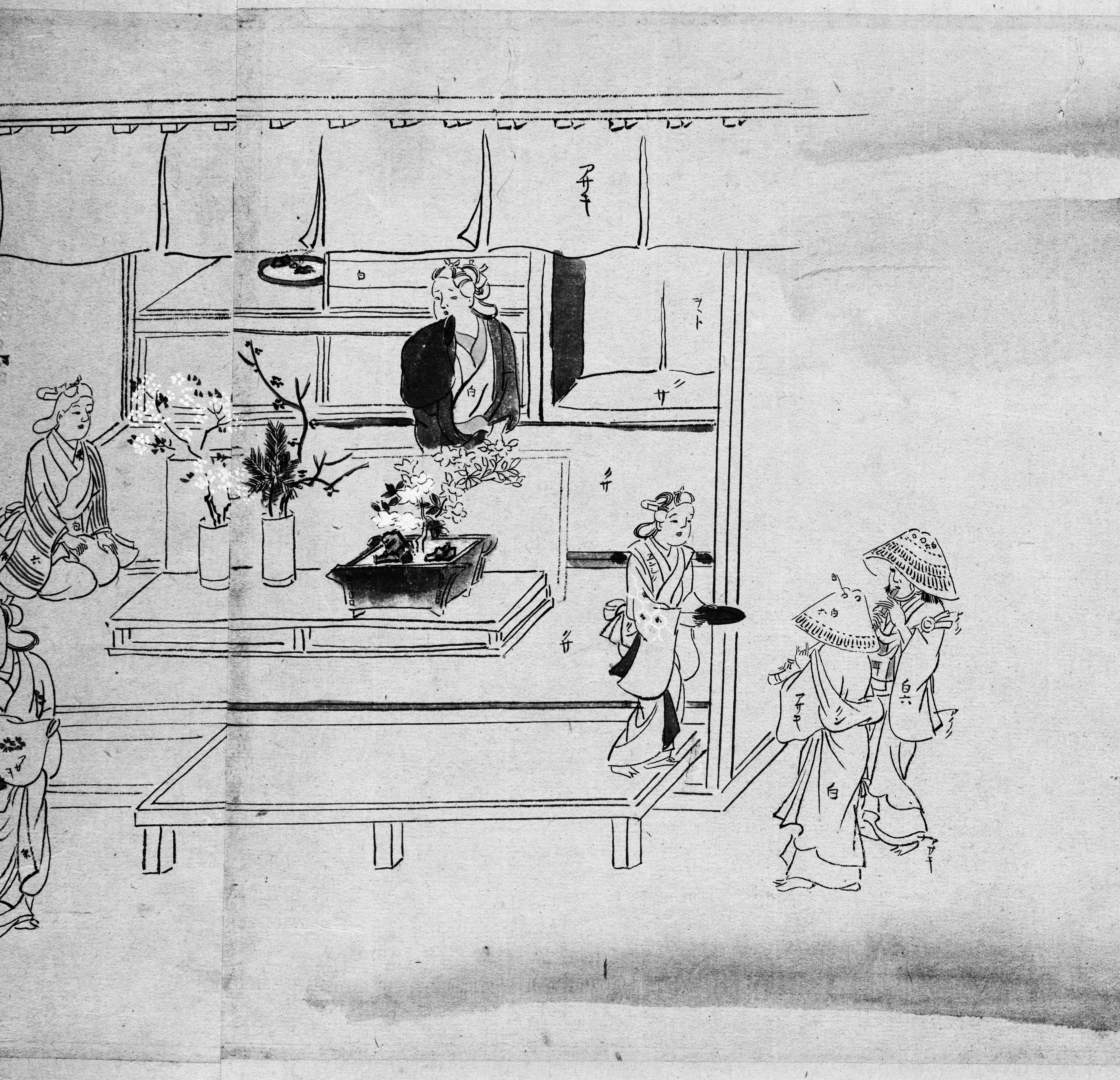
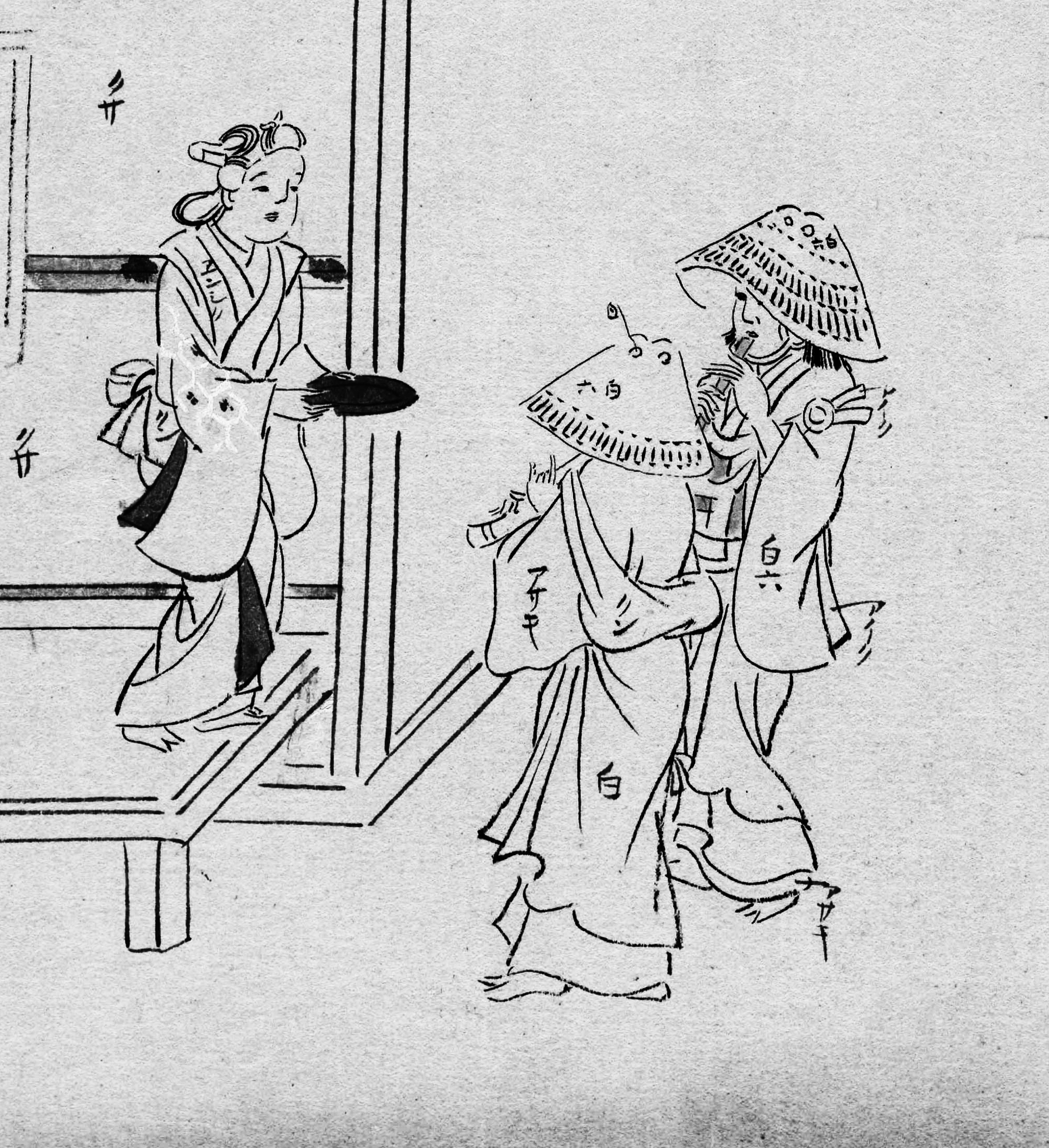
Two komusō receiving alms in the picture scroll 'Shokunin tsukushi waga'
by Hishikawa Moronobu, 1618-1694. National Diet Library Collection.
Edited, in b/w, enhanced, edited by Torsten Olafsson, April 15, 2024.
Probably no later than 1683:
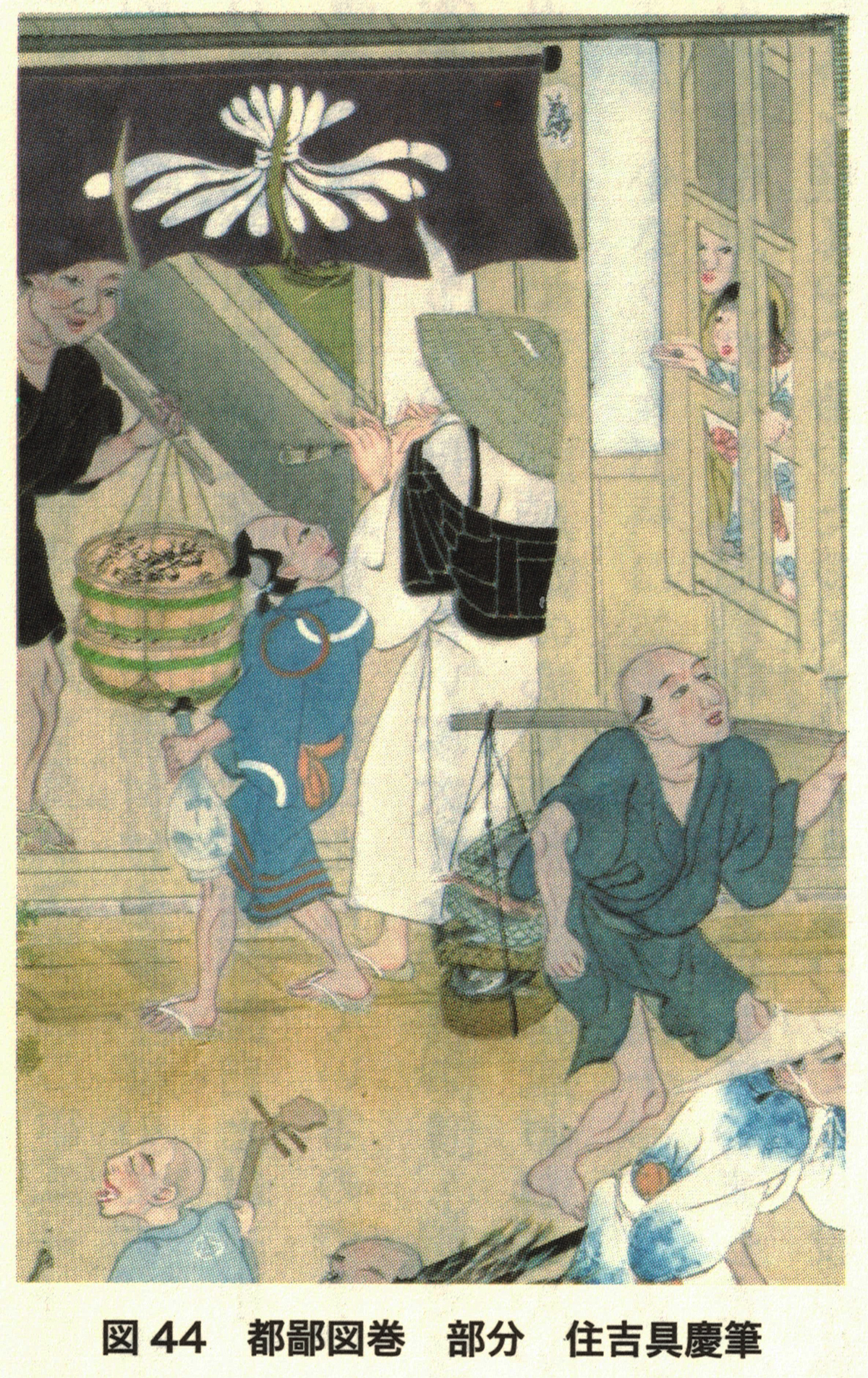
A 'Komusō' playing a root-end shakuhachi in a Kyōto street
Detail from the 'Tohi zumaki', 都鄙図巻, "Sights in and around Kyōto".
A very long and impressive picture scroll painted on silk. By Sumiyoshi Gukei, 1631-1705
Originally a treasure of the Konbu-in in Nara, now exhibited at (link) Tōkyō National Museum
Sumiyoshi Gukei was born and lived in Kyōto until 1683 when he moved to Edo,
present day Tōkyō, where he died in 1705.
In: Izumi Takeo, 2013, p. 93.
1685:
大怒佐 / 大 ぬさ / 大幣 - ŌNUSA
"Streamers" - author/creator unknown
三味線初心書 - Shamisen shoshin-sho
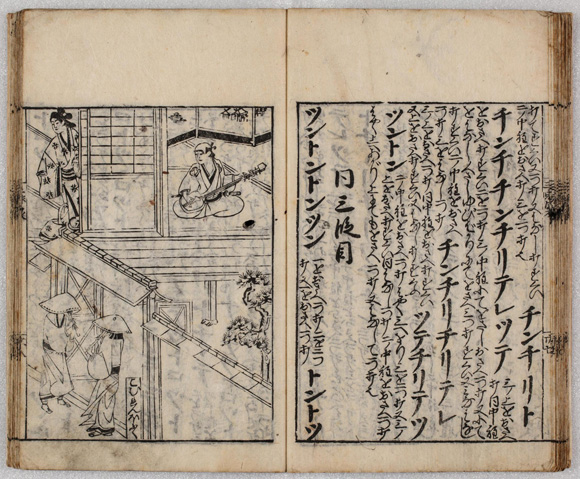
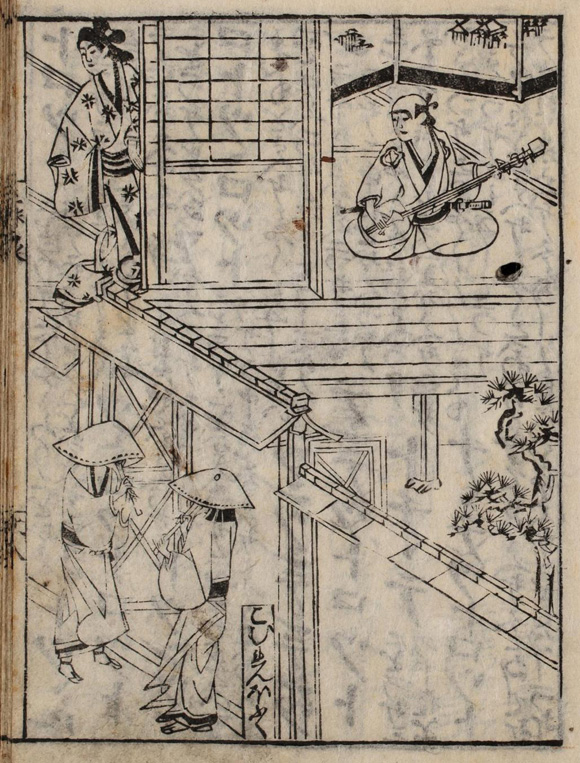
Two 'Komusō' playing thin vertical flutes in front of a gate.
Printed in the shamisen beginners' book 'Ōnusa' in Kyōto, 1685.
Source: Kyōto Institute Library and Archives Search.
Link/URL - PDF frame 29: http://www.archives.kyoto.jp/websearchpe/detail/1779255/1/29
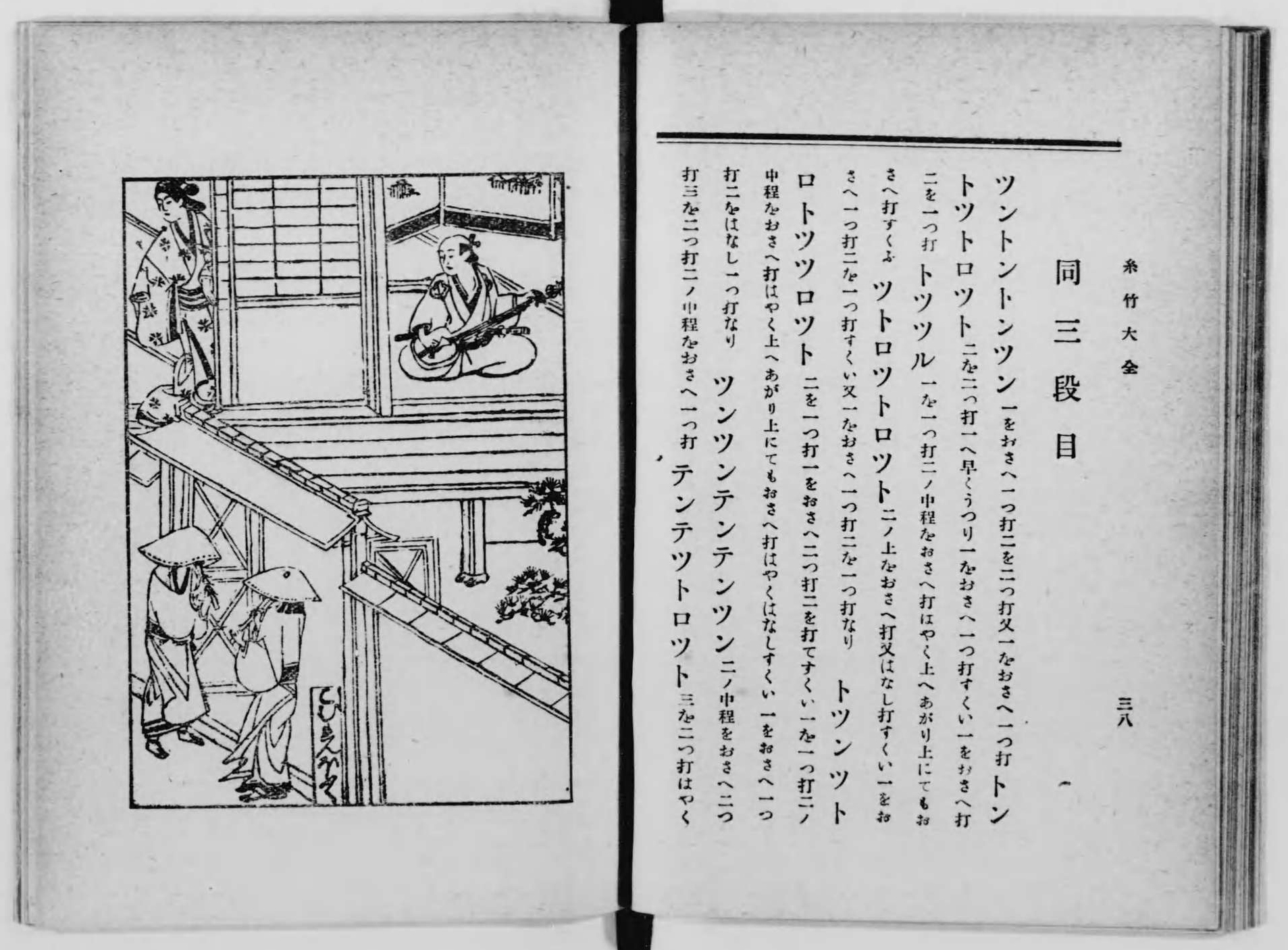
The 'Ōnusa' was also included as a reprint in the 'Shichiku taizen', 糸竹大全, "Encyclopedia of Strings
and Bamboo" in 1687. reprinted in 1699, which, in turn, was reissued in modern typography in 1916.
Link to online version, go to frame 76, c/o The National Diet Library, Tokyo, PDF file
1690:
人倫訓蒙図彙
JINRIN KINMŌ ZU-I
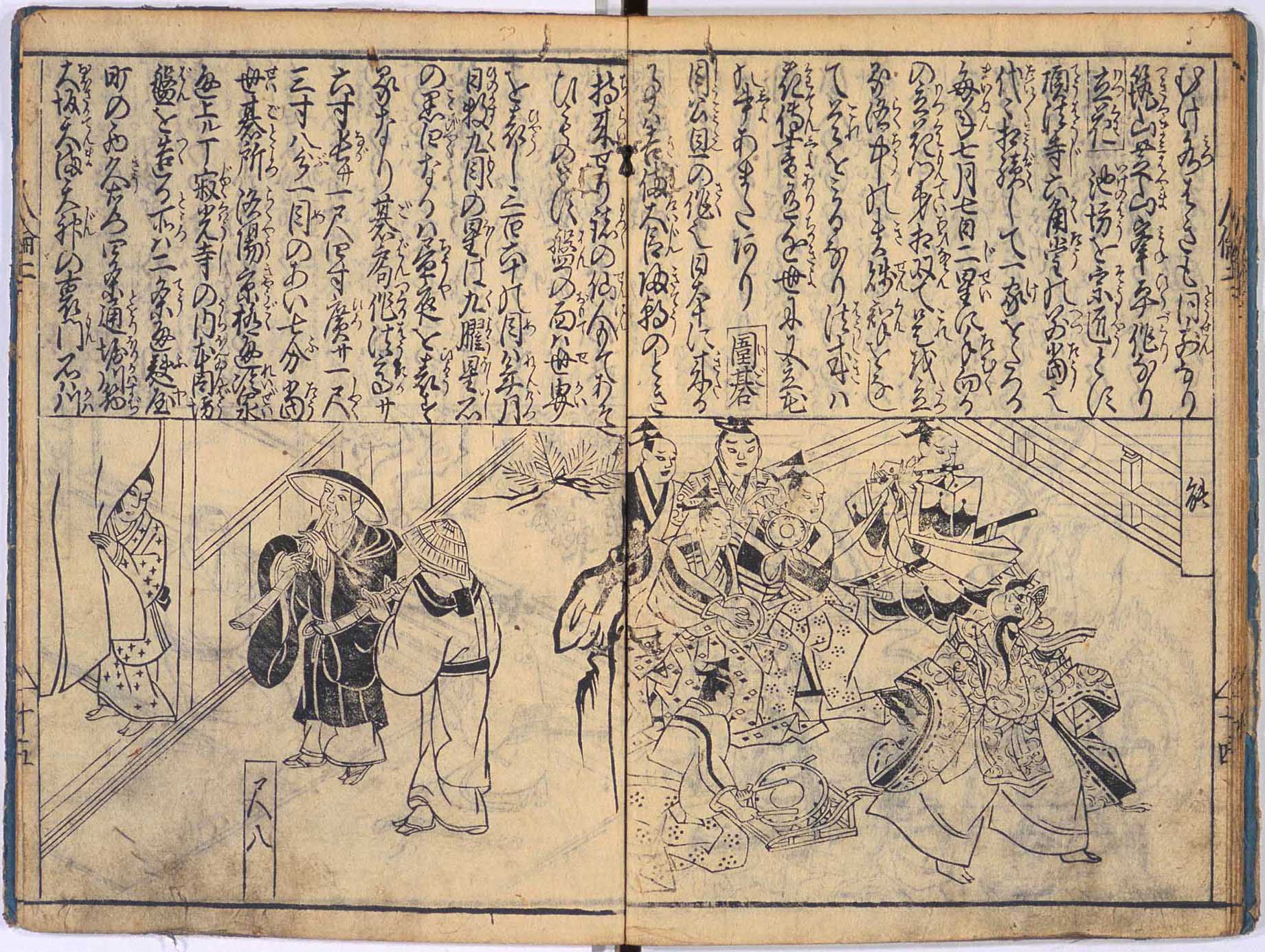
Two 'Komusō' playing long, thick root-end shakuhachi flutes
In: 'Jinrin kinmō zu-i', 1690 - Maki/Vol. 2
By Makieshi Genzaburō
The Library of Kyōto University
Link to Kyōto University's online presentation of this volume
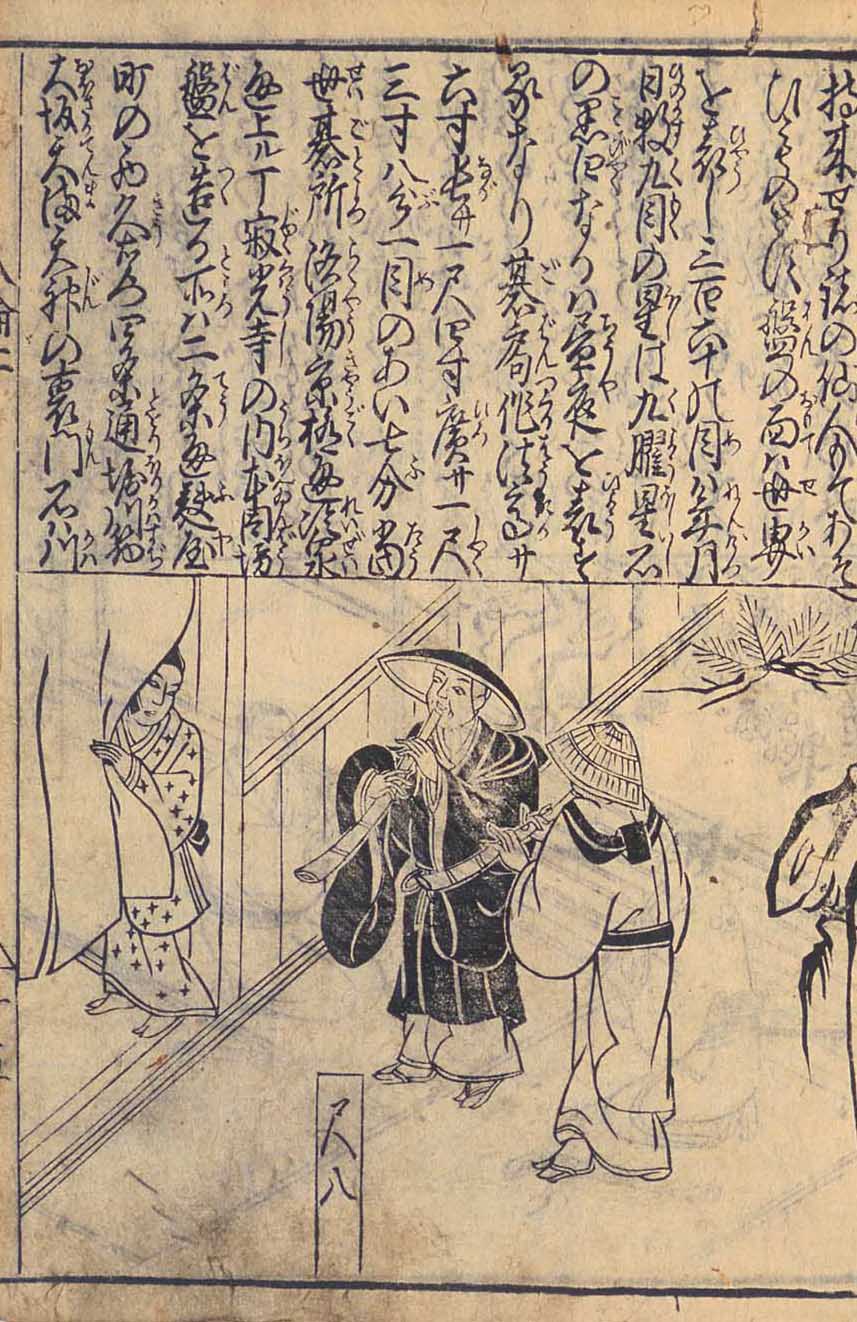
1695 - an entry about 'komo-sō', mat monks, in a Genroku Period encyclopedia:
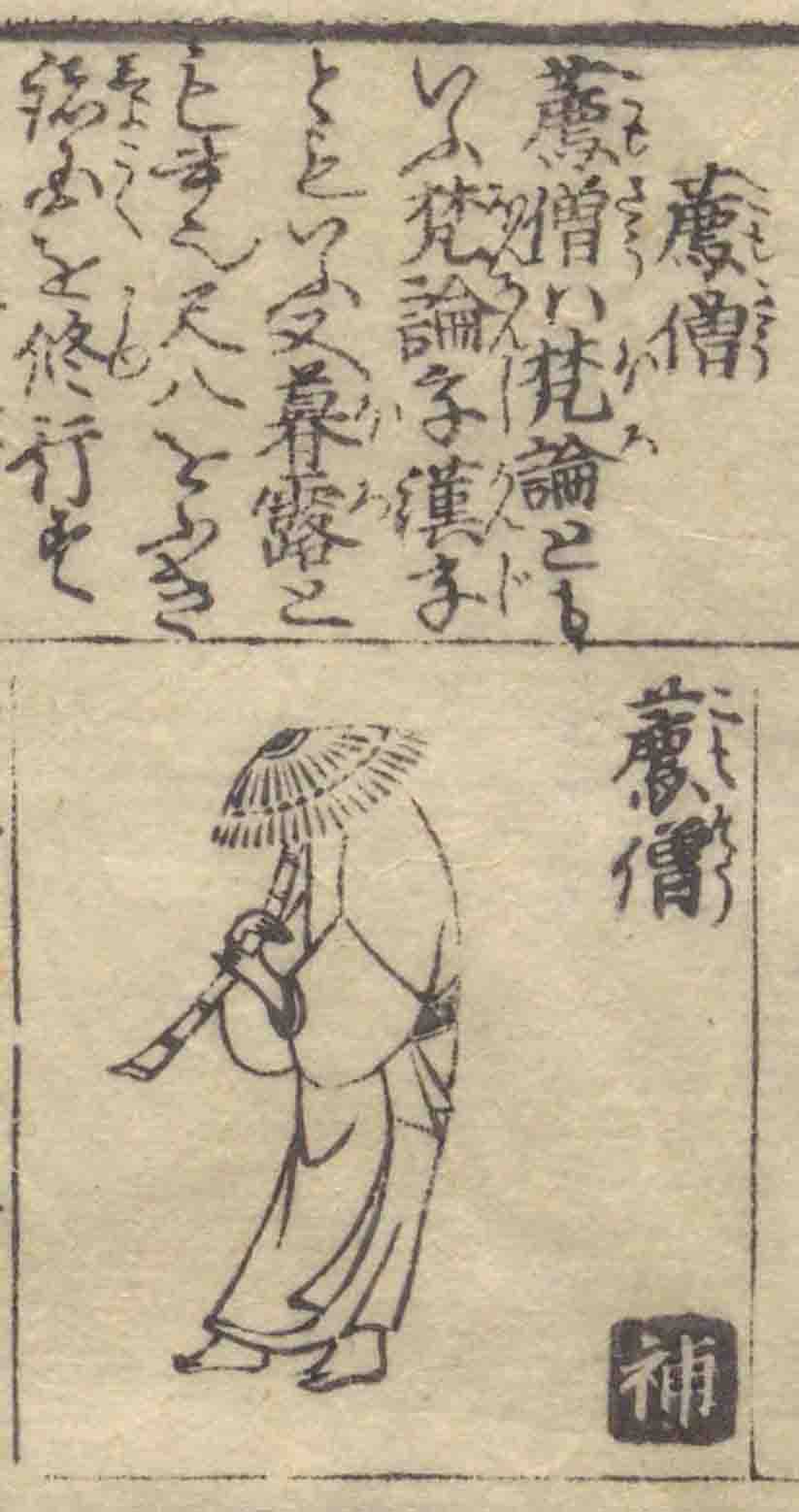
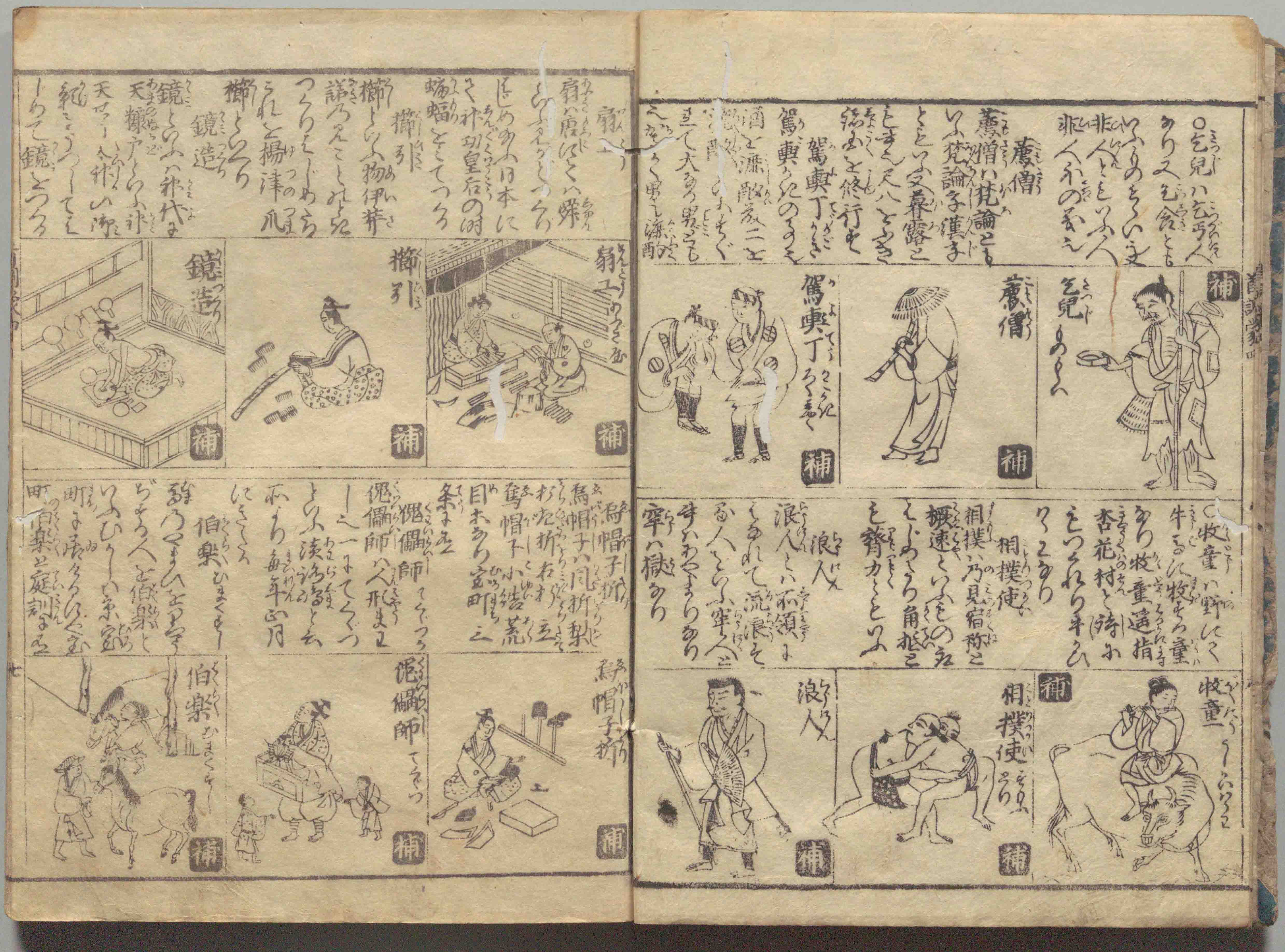
頭書増補訓蒙圖彙
A mendicant shakuhachi player wearing a pointed 'ami-gasa' straw hat
In: 'Kashiragaki zōho kinmō zu-i'
("Enlarged Elementary Encyclopedia with Illustrations"), 1695.
A first edition, 'Kinmō zu-i', was published in 1666.
A third edition, 'Kashiragaki kinmō zu-i taisei', appeared in 1789.
Here, to the right of the flute player, the two kanji for 'komo-sō', 'mat monk',
are given. In the text block above, 'komo-sō' is explained
with the archaic terms of 'bo(n)ron', 'bo(n)ronji', 'kanji', and 'boro'.
The text describing the komosō picture appears to read as follows:
薦僧
薦僧は梵論ともいう、梵論字、漢字ともいう。
又暮露とも書く。尺八をふき、諸国を修行す。
"The "mat monk(s)" is/are also called both 'boron', 'boronji', and 'kanji'.
Besides, one also writes 'boro'. Blowing the shakuhachi,
they perform ascetic practices [shugyō] all over the country."
So, the text concludes that a 'komo-sō' is using the shakuhachi for 'shugyō",
修行, "ascetic practice"
- which is, certainly, not only limited to Zen Buddhist traditions, though.
Do observe, however, that the term "ascetic practice" does NOT refer to a "practice of shakuhachi meditation" in any way, but to the humble act of religious begging, only - known as 'taku-hatsu', 托鉢.
National Diet Library, Tokyo, direct link
1696 - a lonesome 'Komusō' in a Genroku Period "floating world" story collection:
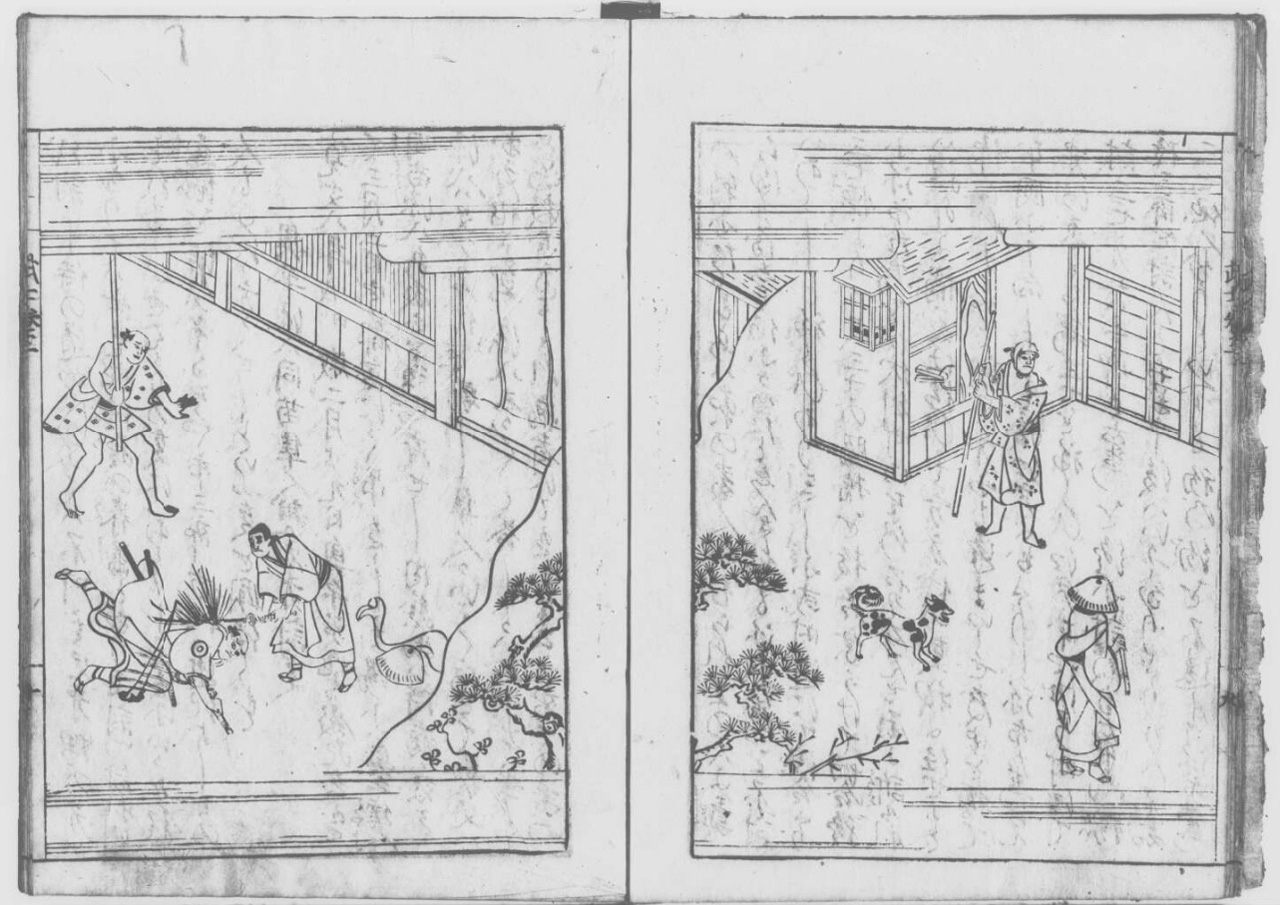
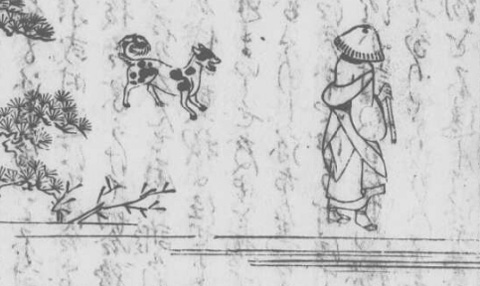
This very rarely shown picture of a wandering 'Komusō' is depicted in Volume 3, on page 16, in the 1696 'ukiyo-zōshi', "floating world", story collection 'Kokon bushi kagami', 古今武士鑑,
a.k.a. 'Nippon bushi kagami, 日本武士鑑, which was created by Mukunashi Issetsu, born 1631, 椋梨一雪,
and published in both Ōsaka and Kyōto in the year Genroku 9.
The figure is not mentioned nor in any way characterized in the text to which it is attached.
The Kyūshū University Library, among other archives, owns an original copy of this precious work.
1698:
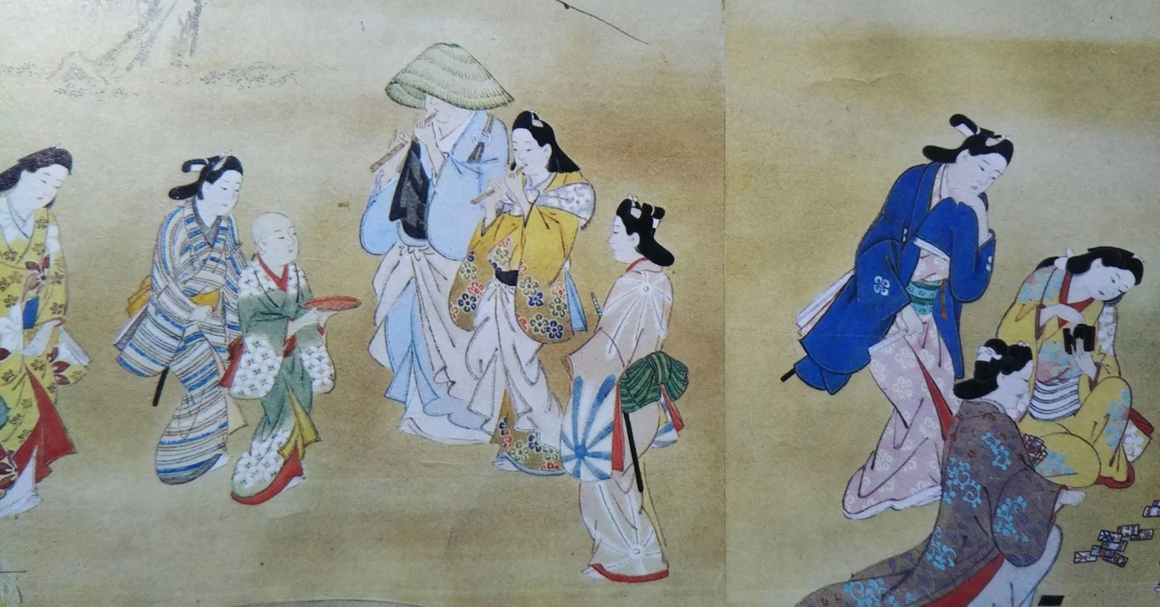
Two flute players in 'Edo fūzoku zu-maki' by Miyagawa Chōshun, 1683-1753.
Interestingly, while the figure to the left has the obvious appearance of a 'komusō', the person to the right does not wear a 'tengai' basket hat and quite much looks like an elegant female.
Presented online by Shakuhachi-Kataha, link to web page:
https://note.com/kataha_comjo/n/nb964ee048e6c
Early 18th CENTURY
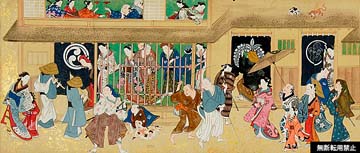
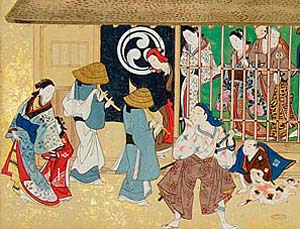
A pair of 'Komusō' depicted in the 'Hanamachi fūzoku-zu emaki',
"Picture scroll of Manners and Customs on the Flower Avenue",
i.e. in the pleasure quarters - early 18th century
Artist unknown. The Tobacco and Salt Museum, Shibuya-ku, Tōkyō
1724:
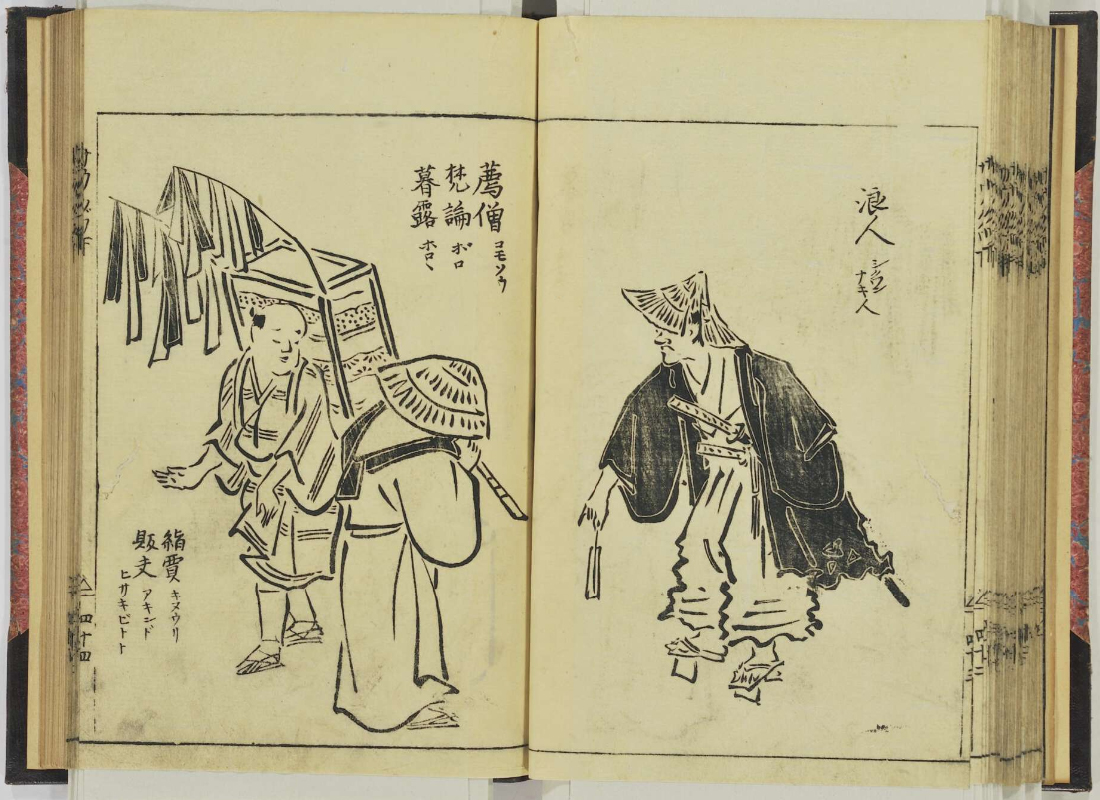
'Komusō' and 'Rōnin' in the 'Jinbutsu sōga'
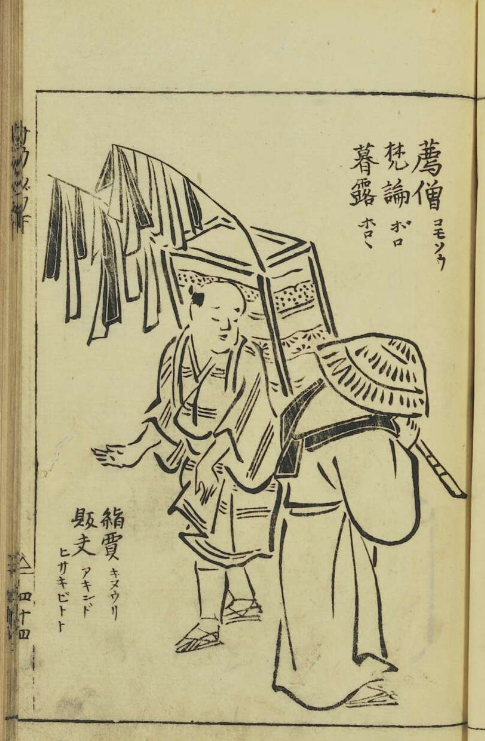
Discovered in a humoristic 1724 picture book illustrated by Myōyo Kokan, 明誉古礀, 1653-1717.
In the British Museum, London, link:
https://www.britishmuseum.org/collection/object/A_1953-0509-0-2
1758:
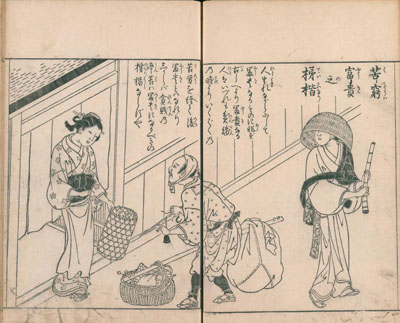
'Komusō' in a street, wearing a rather "deep" 'tengai'
In: "Ehon mitsu wagusa', volume 2, 1758
by Nishikawa Sukenobu (1671-1750)
Source: National Diet Library, Tōkyō
1768:
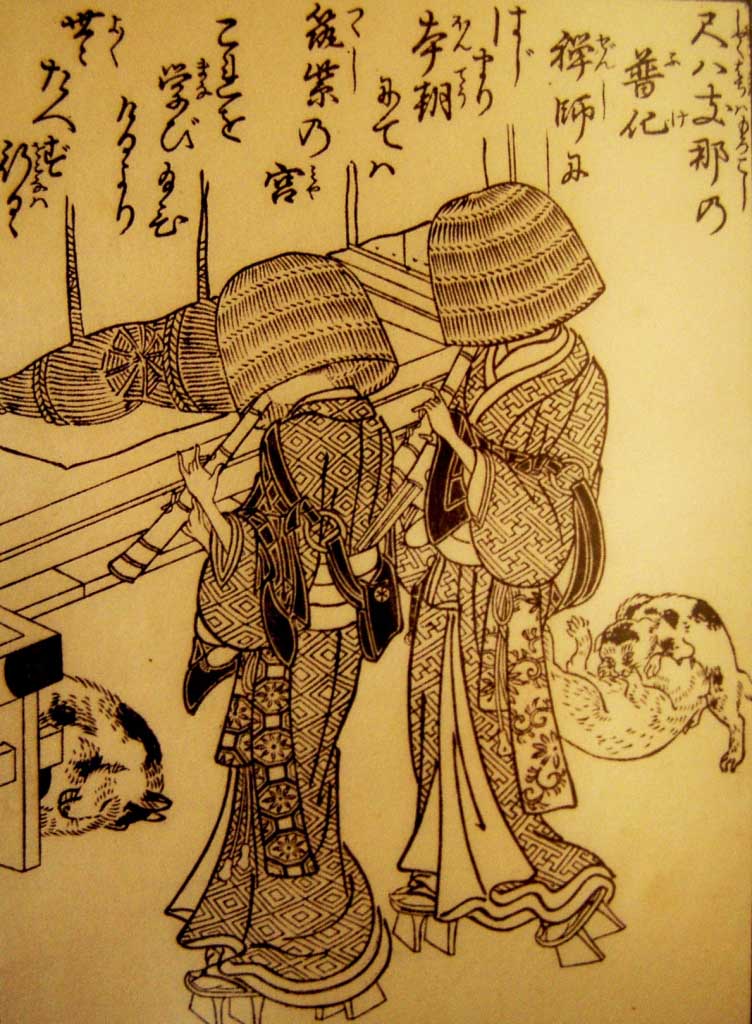
Book print of two 'Komusō', 1768.
In: 'E-hon Azuma no hana', "Picture Book of Flowers of the East"
Illustration by Shigemasa Kitao, 1739-1820
Ritsumeikan University, Kyōto.
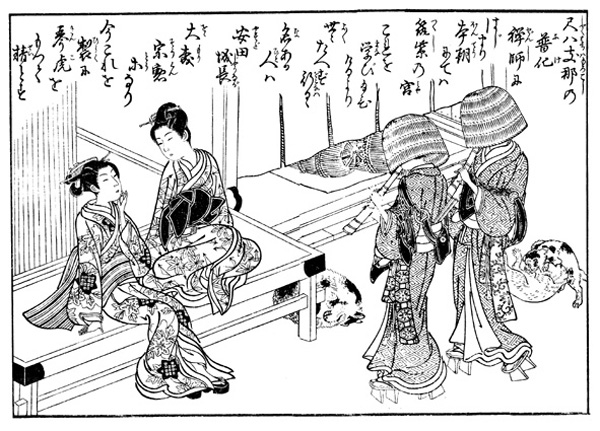
Source: http://www.rounanusi.jp/syakuhatisyouki/87mudai/86mudaitop.html
This is, so far, the oldest known 'Komusō' picture the accompanying text of which
features the name of Fuke Zenji, 普化禅師, at the top, right.
The text at the top reads as follows:
Right side text:
尺八支那(しゃくはちハもろこし)の普化禅師にはじまり 本朝にては筑紫(つくし)の宮これを学び給ぶひけるにより 世々たへず行(おこなハ)るゝ。
"Shakuhachi began with Zen monk Fuke [P'u-k'o] in T'ang China [Morokoshi].
In our country [this dynasty] it was studied and taught in the Palace of the Nara Province [the Tsukushi Palace]."
Left side text:
名ある人ハ安田城長(やすだじやうなが) 大森宗勲(おおもりそうくん)等(とう)なり 今これを製 (ひらく)に 琴虎(きんこ)もって精(せい)とす。
"Famous people [who played it] were Yasuda Shironaga [Jōnaga?], Ōmori Sōkun and others. Nowadays it is being finely made strong with the use of 'kinko' [? lit. 'zither+tiger']."
Trsl. by T.O. 2017
1781/1784:
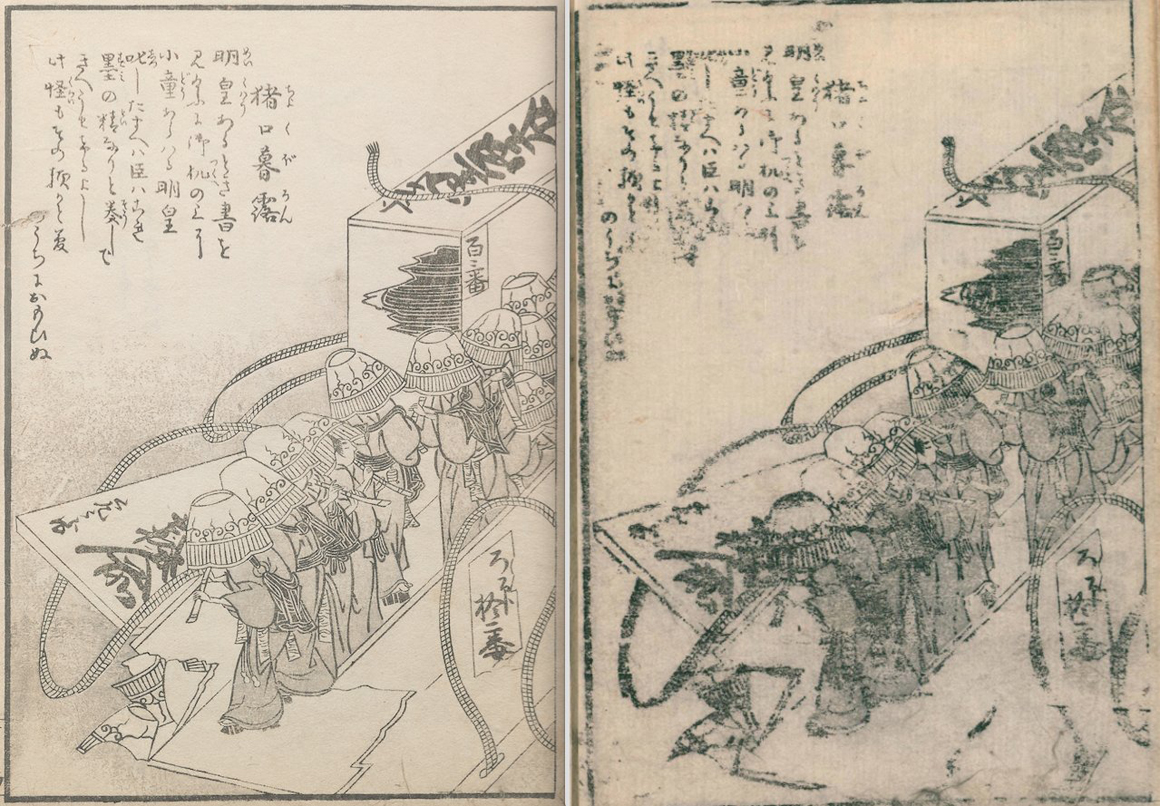
Toriyama Sekien's 1784 pictorial work focusing on demons in Japanese folklore,
titled Gazu Hyakki Tsurezure Bukuro, "The Illustrated Bag of One Hundred Random Demons",
also includes a picture of 'komusō' look-a-likes lined up wearing sake cups on their heads.
Read more here: https://en.wikipedia.org/wiki/Gazu_Hyakki_Tsurezure_Bukuro
1789:
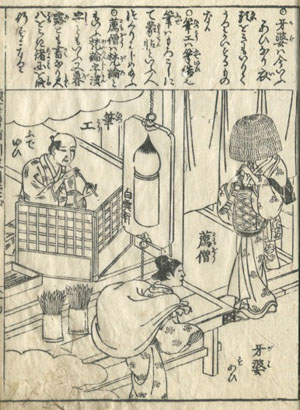
A shakuhachi player wearing a bee-hive-shaped 'tengai'.
Do note that the Japanese characters to the left of the fluteplayer
reads 'komo-sō', not 'komu-sō'.
In: 'Kashiragaki zōho kinmo zu-i taisei'
('Enlarged Elementary Encyclopedia with Illustrations,
Complete edition'), Kansei 1, 1789, volume 4: "People".
Author: Nakamura Tekisai (1629-1702). Illustrator: Shimokawabe Shūsui.
The first edition, 'Kinmō zu-i', was published in 1666.
The second edition, 'Kashiragaki kinmō zu-i, appeared in 1695.
1791:
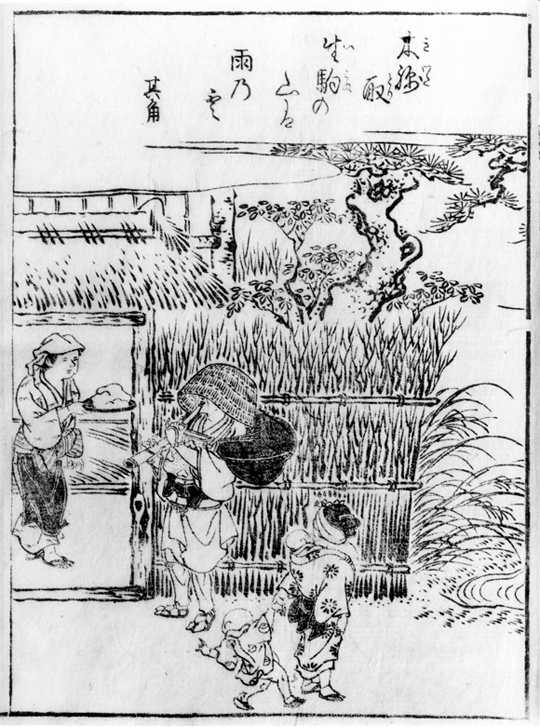
Woodcut print of a 'Komusō' receiving alms
In: 'Yamato meisho zue', 大和名所図絵, "Pictures from Famous Places in Japan"
Illustration by Takehara Shinkei, 1791
The National Museum of Denmark, Department of Ethnography, Copenhagen
Photo reproduction by John Lee.
Link to the Waseda University Library online archive - go to picture 43:
Woodcut print of a 'Komusō' receiving alms, 1791
1795:
KYOTAKU DENKI KOKUJIKAI - THE ILLUSTRATIONS
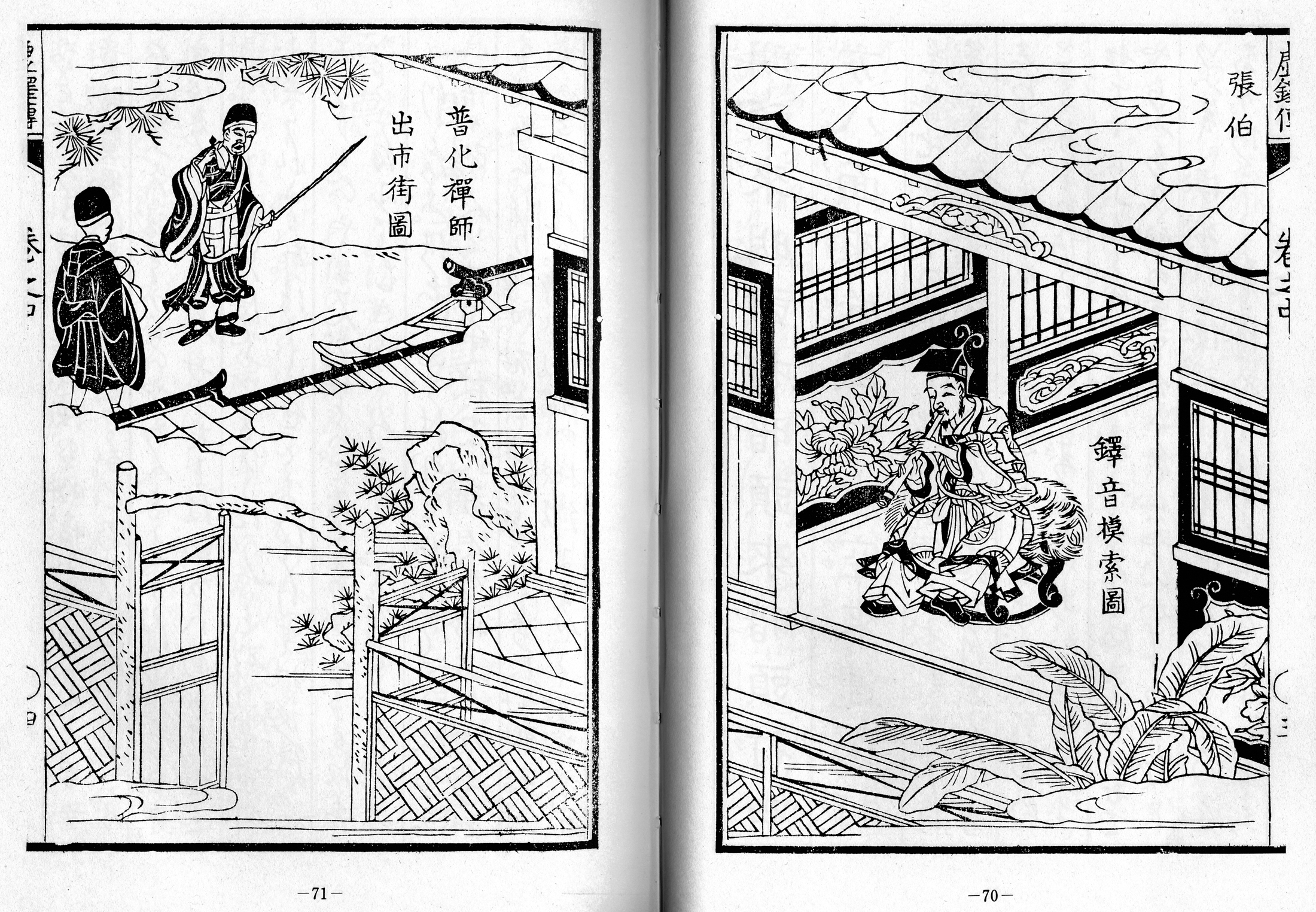
1795, Kyotaku denki kokujikai: Early 9th century Fuke, ringing his bell, and alleged
'Kyorei' "composer", Chōhaku, with his supposed "Chinese shakuhachi".
How come that the illustration shows a typical late 18th century root-end 'shakuhachi',
not some original 9th century Chinese vertical flute with 6 fingerholes?

1795, Kyotaku denki kokujikai: Early 9th century Fuke, ringing his bell, and alleged
'Kyorei' "composer", Chōhaku, with his supposed "Chinese shakuhachi".
How come that the illustration shows a typical late 18th century root-end 'shakuhachi',
not some original 9th century Chinese vertical flute with 6 fingerholes?
Source of illustrations:
Kowata Suigetsu, compiler & editor: Kyotaku denki kokujikai.
By Yamamoto Morihide, Kyōto, 1795.
216 pages, Nihon ongaku-sha, Tokyo, 1981.
1798:
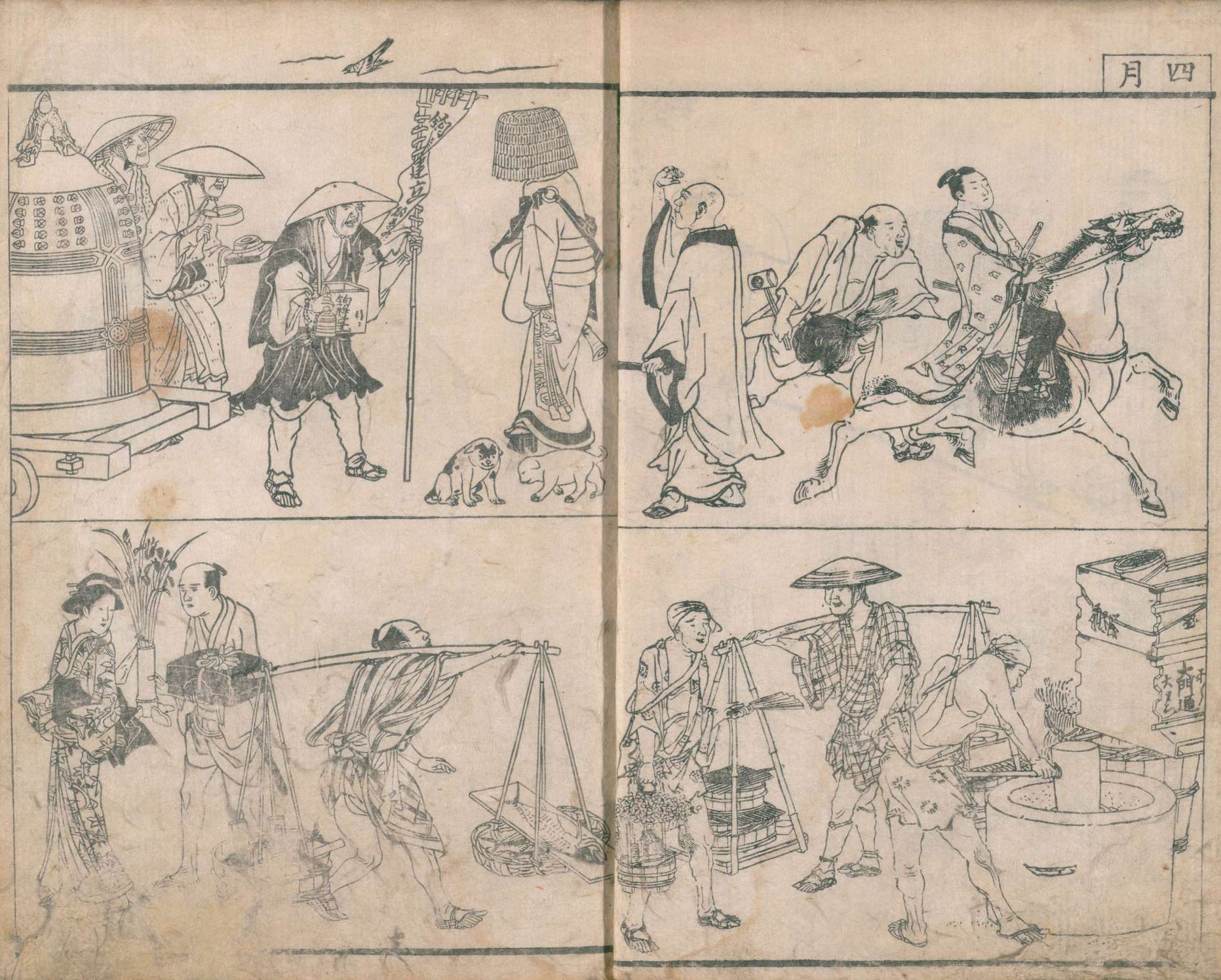
'Komusō' on foot among people in an Edo street, 1798.
In the small illustrated story book 'Shiji no yukikai',
"Associations of the Four Seasons" by artist Kitao Shigemase, 1739-1820,
and author Santō Kyōgen, 1761-1816.
1799:
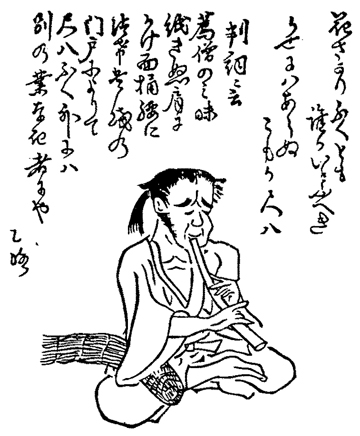
This particular illustration and accompanying text designed and presented by Ban Kōkei, 伴蒿蹊, 1733-1806, in his work Kanden Kōhitsu, "Essay on the Cultivation of the Fallow Fields", has created quite some confusion and miscomprehension in the Western shakuhachi world regarding how a 'komosō' might have looked like about 500 years ago.
It can not be relied upon as truthful 15th century 'Komo-sō:' historical evidence, at all. T.O. 2013.
1806:
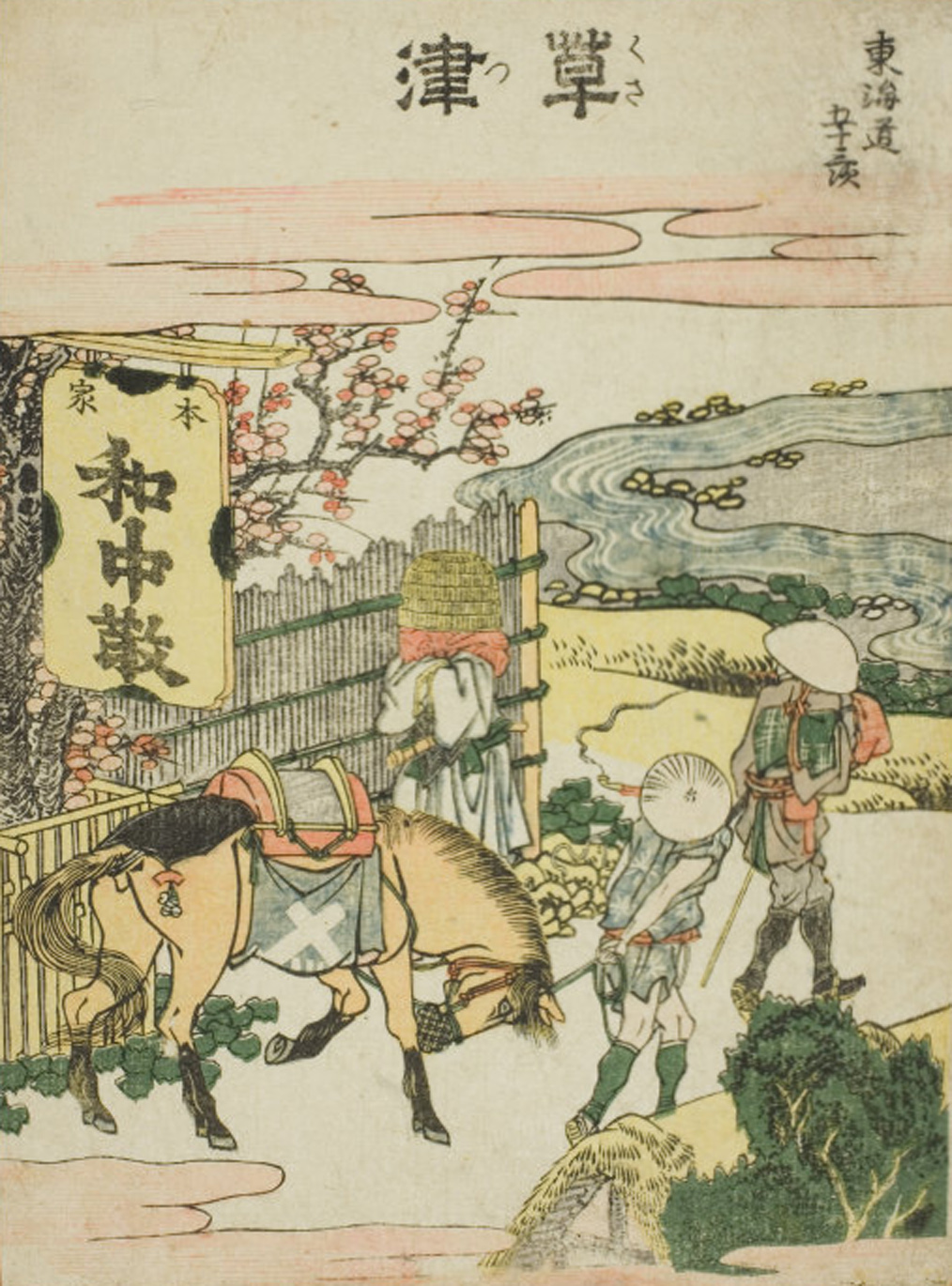
Wood cut print of a 'Komusō'
No. 53, 'Kusatsu', in: 'Tōkaidō gojūsan tsugi',
"53 Stations of the Tōkaidō", 1806 edition.
Ukiyo-e print by Katsushika Hokusai, 1760-1849.
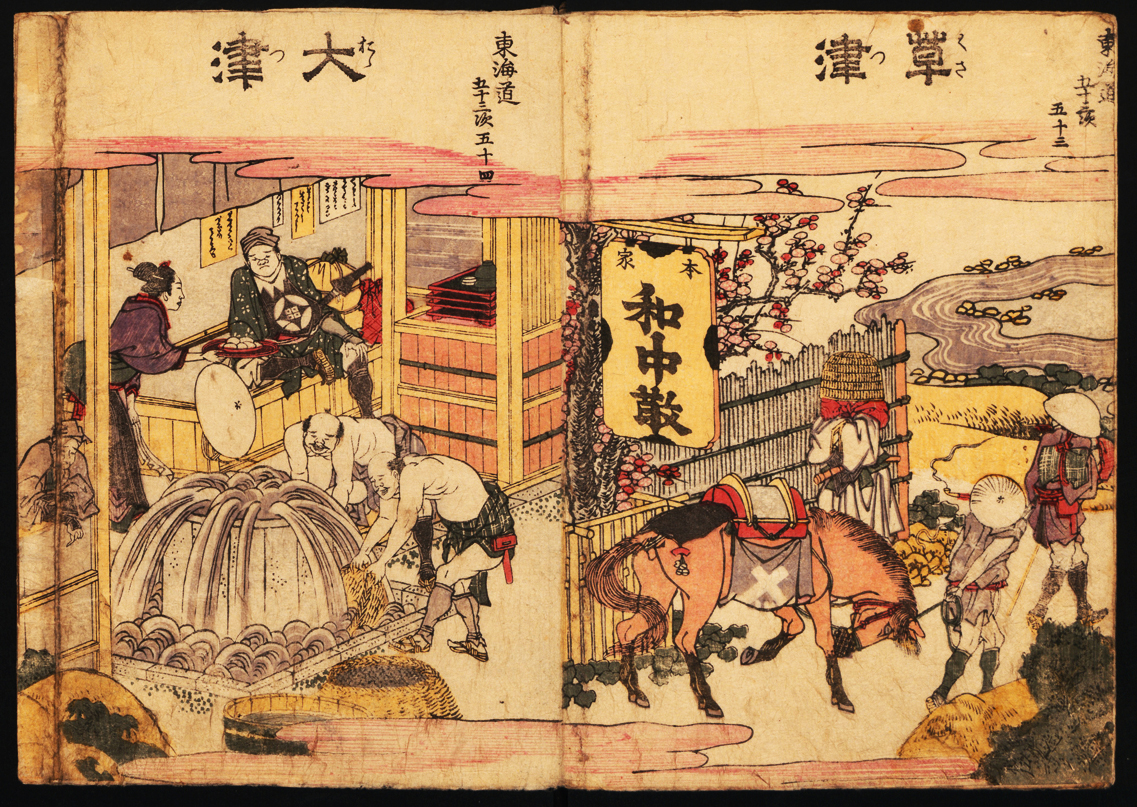
Interestingly, however: Dated "1840" by the Metropolitan Museum of Art ... ?
1810:
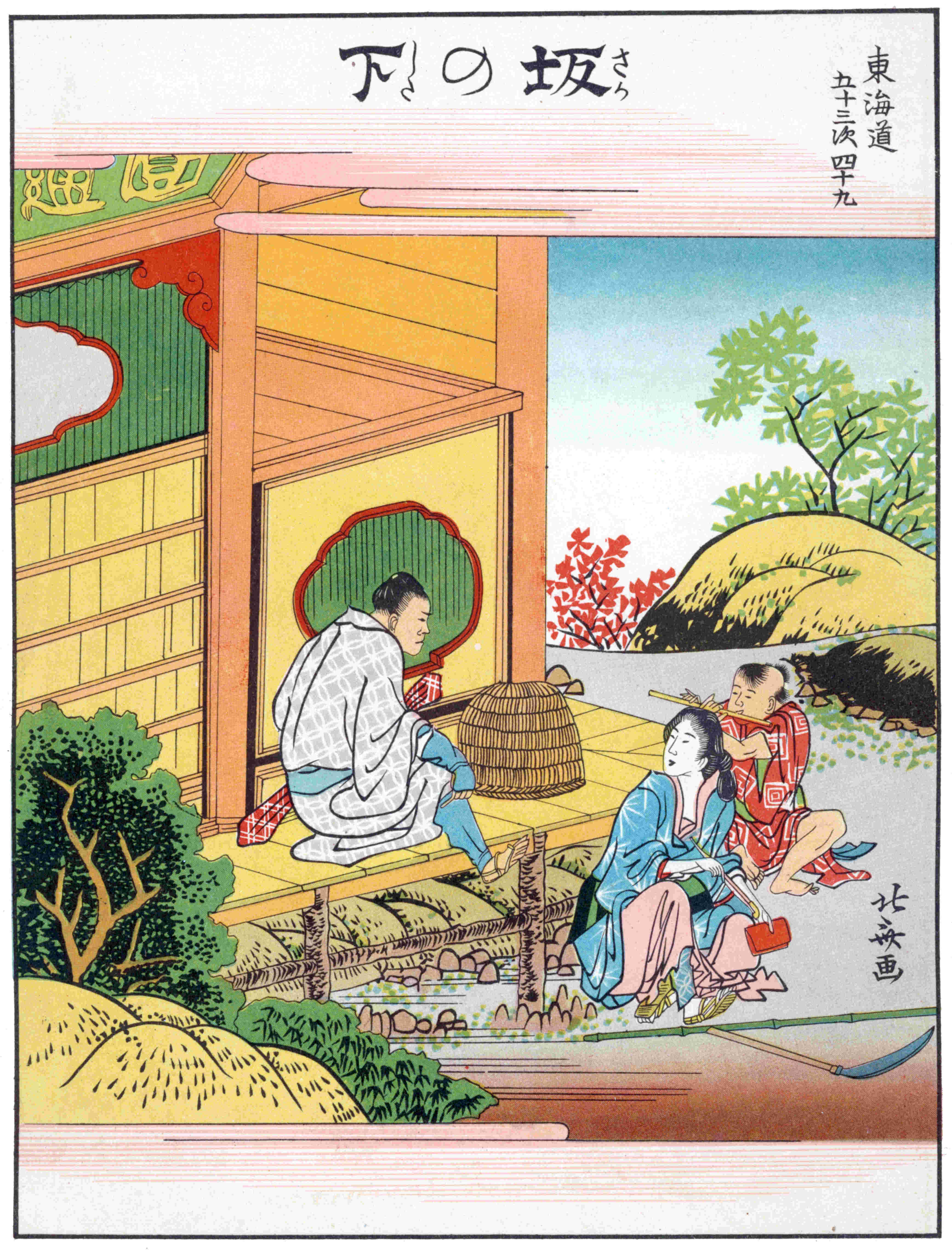
By Katsushika Hokusai, "The 53 Stations of the Tōkaidō", Number 49: 'Saka-no-shita'.
This is actually the one and only known image of an Edo Period 'Komusō' pictured as seated, resting
on a veranda, during a stopover, while his 'tengai' is placed on the veranda, not covering his head
as we otherwise always see in all the numerous known published pictures.
EARLY 19th CENTURY:
Travelling 'komusō' in the Art of Ukiyo-e:
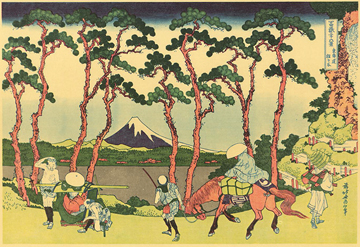
Wood-block print by Katsushika Hokusai, ca. 1828
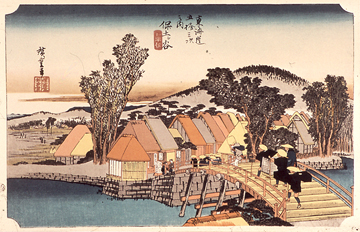
Wood-block print by Andō Hiroshige, 1833
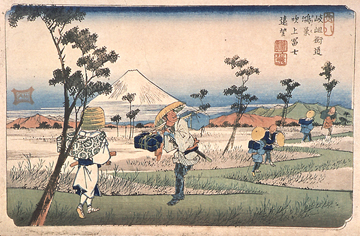
Wood-block print by Ikeda Eisen, 1833
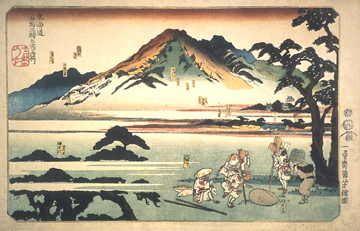
Wood-block print by Utagawa Kuniyoshi, 1834
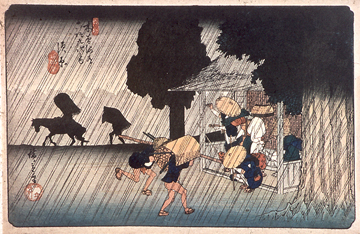
Wood-block print by Andō Hiroshige (lived 1797-1858)
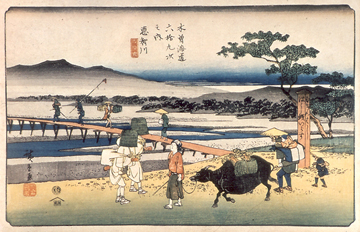
Wood-block print by Andō Hiroshige or Ikeda Eisen (lived 1790-1848)
1832:
"Pelgrims/Pilger"
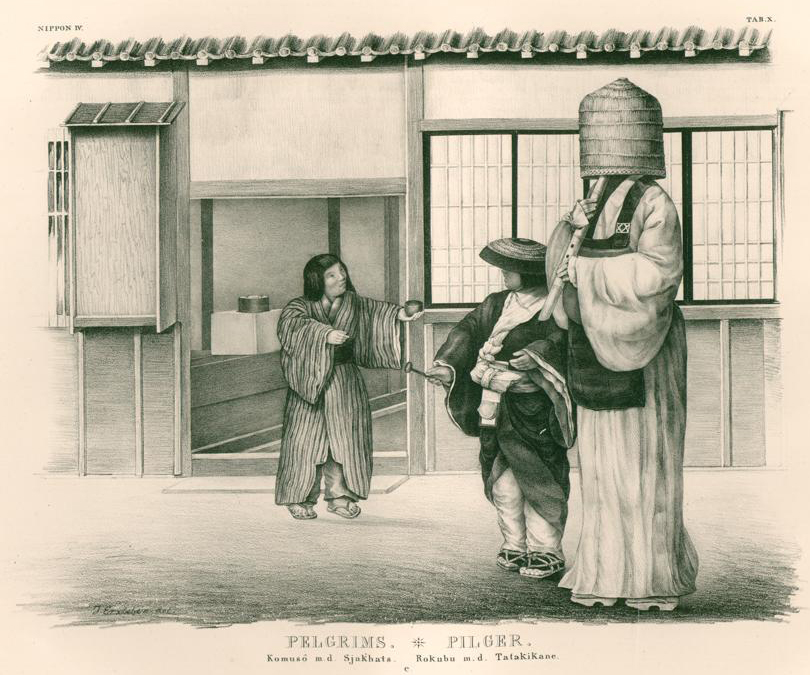
'Komusō' "Pelgrims/Pilger" in Philipp Franz Balthasar von Siebold's "Nippon",
Tafelband 2, first published in 1832.
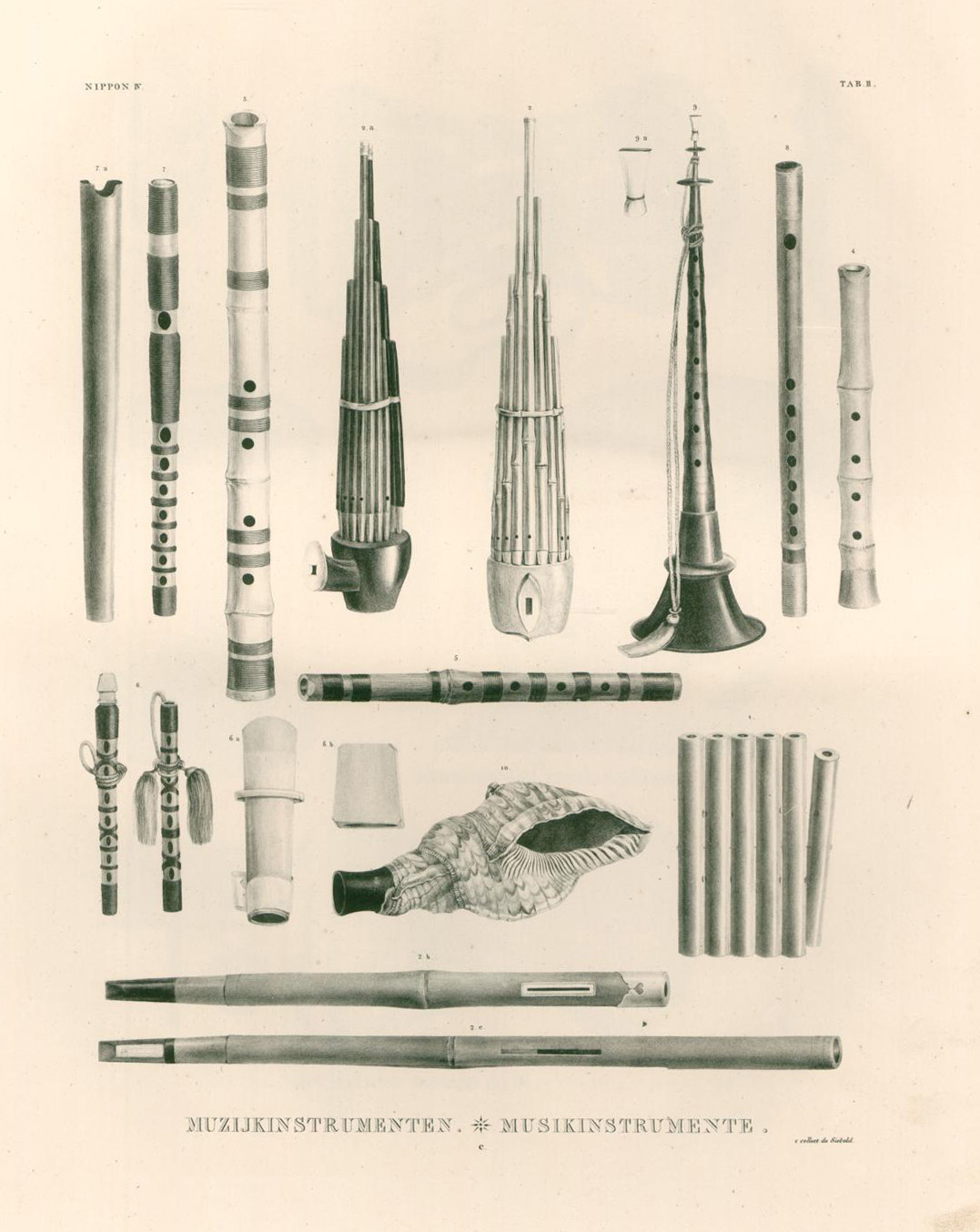
Japanese wind instruments in Philipp Franz Balthasar von Siebold's "Nippon",
Tafelband 2, first published in 1832.
c. 1840?:
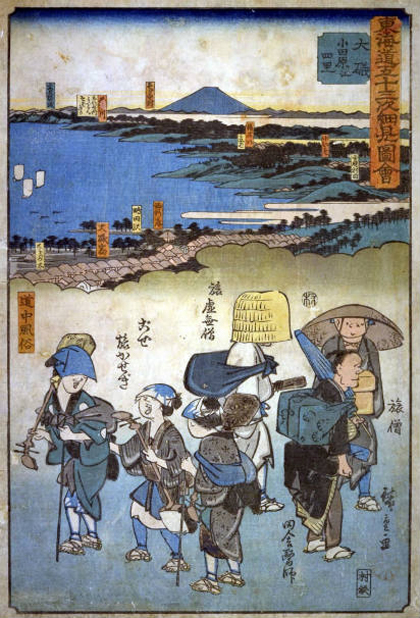
Wood cut print by Utagawa Hiroshige showing a travelling 'Komusō', c. 1840?
Picture contained in Hiroshige's lesser known work
'Tōkaidō gojūsan tsugi saiken zue',
"Details from "The 53 Stations of the Tōkaidō".
Source: The National Diet Library, Tōkyō.
Possibly the late Edo Period during the mid-1800s?:
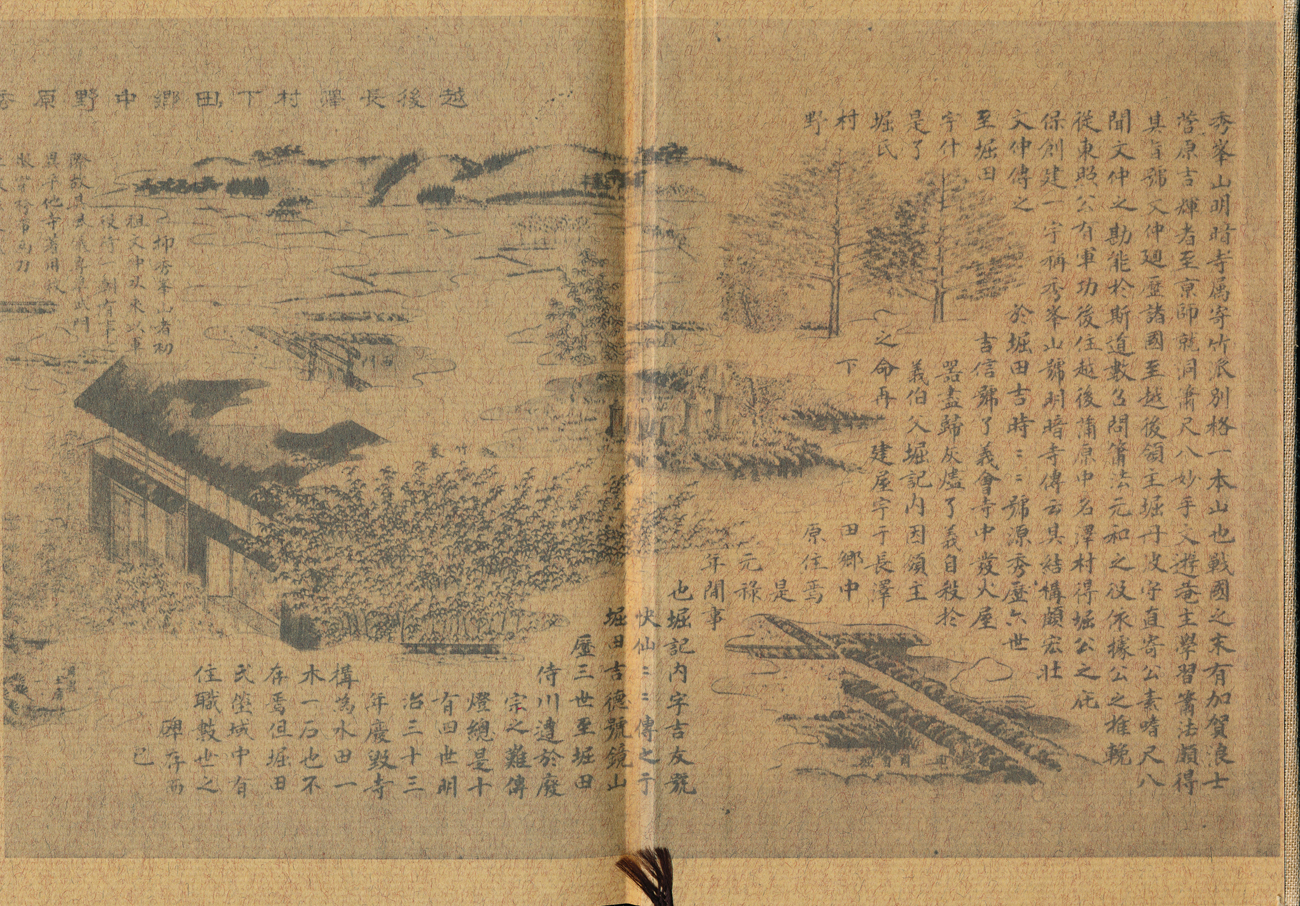
Horizontal scroll depicting the Edo Period Myōan Temple in the Echigo Province. No date given.
Printed on the inside front, of the hard cover binding of Tomimori Kyozan's ' 'Myōan shakuhachi tsūkai', Tokyo, 1979.
Right section of the scroll. Click in the picture to enlarge and open in a new window.
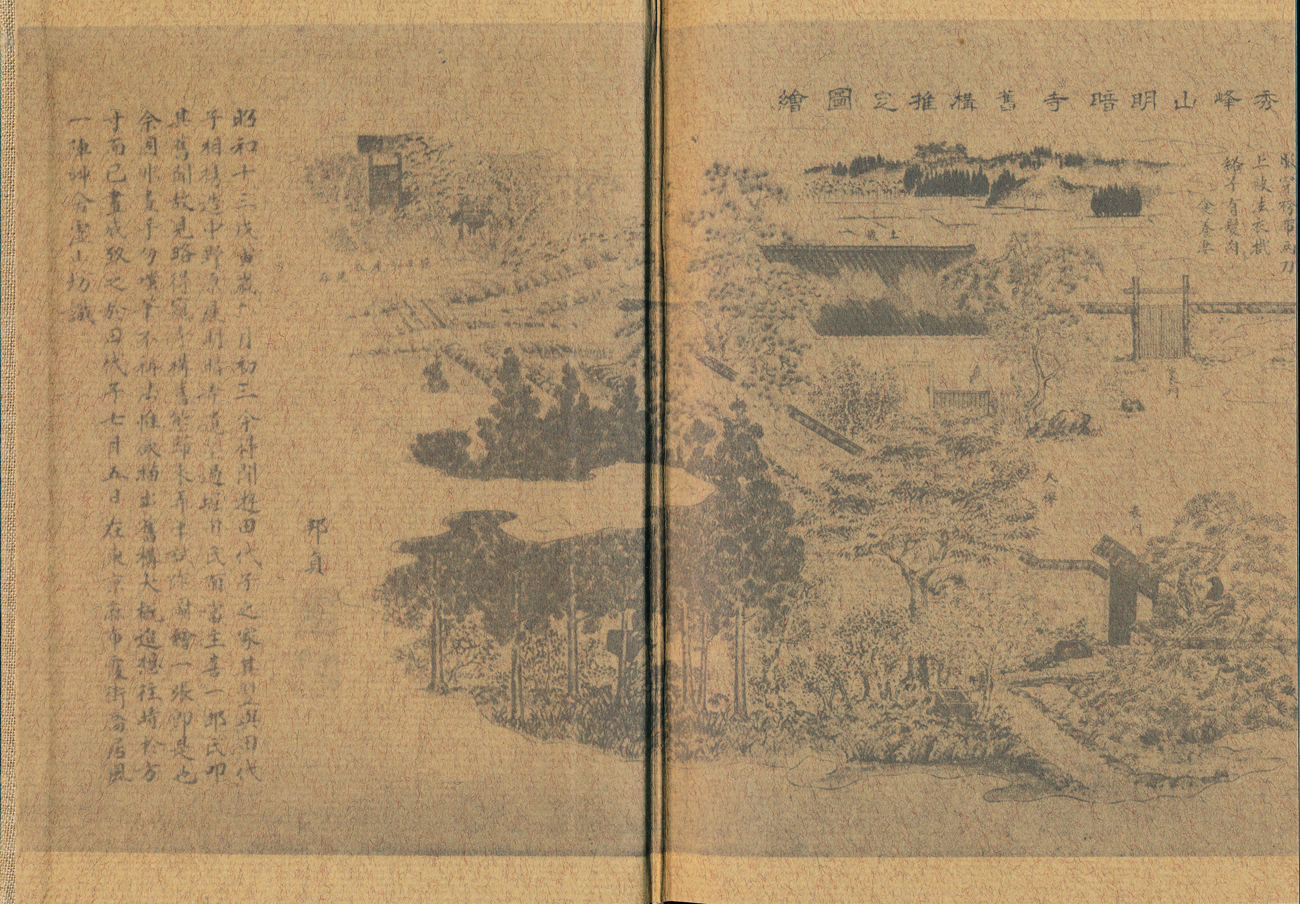
Horizontal scroll depicting the Edo Period Myōan Temple in the Echigo Province. No date given.
Printed on the inside, back, of the hard cover binding of Tomimori Kyozan's ' 'Myōan shakuhachi tsūkai', Tokyo, 1979.
Left section of the scroll. Click in the picture to enlarge and open in a new window.
1851-1852:
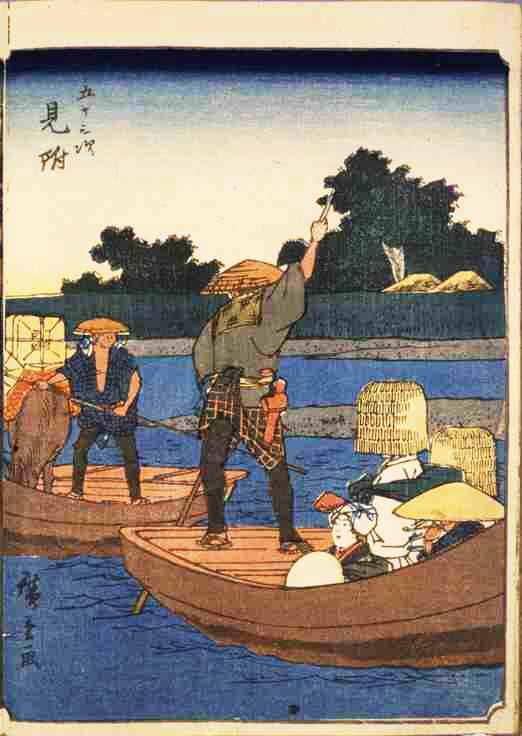
Two 'Komusō' crossing the treacherous river Tenryū at the locality Mitsuke.
From the series "Fifty-three Stations of Tōkaidō".
Wood-cut print by Utagawa Hiroshige, produced in 1851-52.
1853:
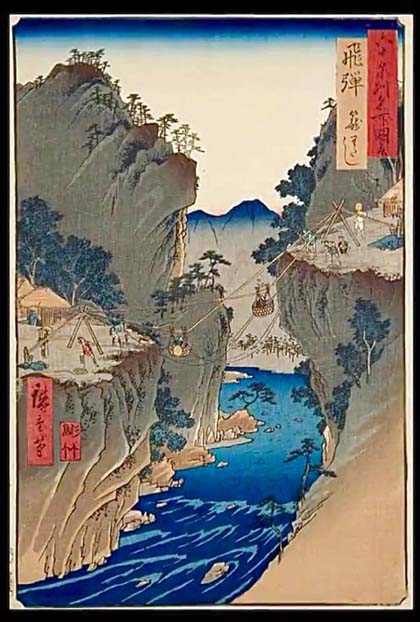
Apparently, at the top right a travelling 'Komusō' is waiting to be "ferried" over the abyss - in a basket.
Ukiyo-e by Utagawa Hiroshige in the series "Famous Places in the Sixty-odd Provinces ", dated 1853.
Source: https://ukiyo-e.org/image/bm/AN00531999_001_l
Possibly the late Edo Period during the mid-1800s?:
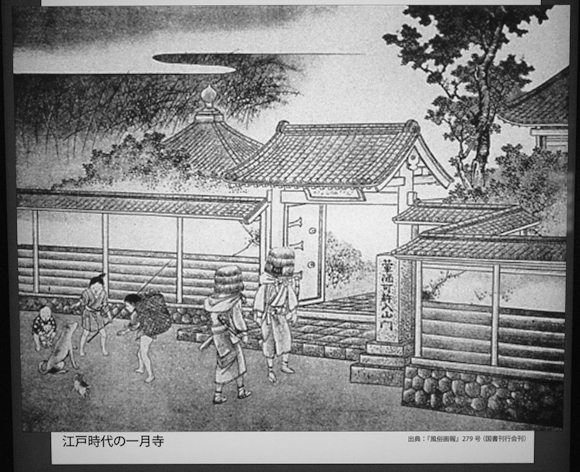
Gate of the Edo temple Ichigetu-ji in Machido, NW Chiba, possibly during the 1800s.
In the illustrated news publication 'Fūzoku gahō', 風俗画報,
No. 279, December, 1903. Photo by Ron Nelson. Matsudo City Museum, Chiba.
The print is also displayed on this web page: http://takenokaze.in.coocan.jp/tour/matudo_hakubutu/matudo_hakubutu.htm.
1850s?:
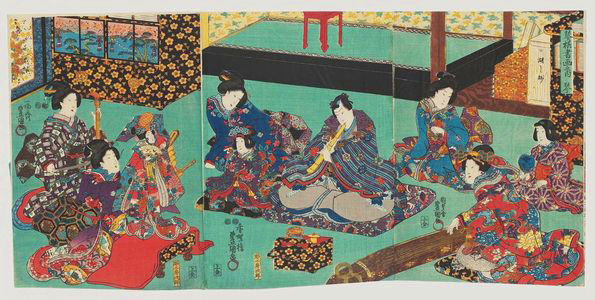
Ukiyo-e by Katsushika Ōi, daughter of the renowned ukiyo-e artist Katsushika Hokusai.
The scene may only have been imagined by Ōi-san - however: Was the 'shakuhachi' already used
in place of the 2-stringed 'kokyū' "violin" in 'ji-uta' and ' sankyoku' ensembles
as early as in the mid-1800s?
1860s? - The Final Days of the Tokugawa Period 'Komusō'
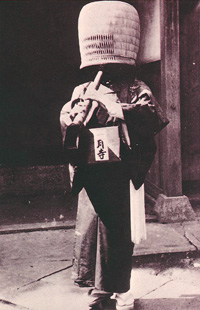
Ichigetsu-ji 'Komusō' - late Tokugawa Period
Photograph in the collection of the Matsudo City Culture Hall, Tōkyō
Name of photographer unknown. In: Kikan hōgaku 5, 1975
1861/1864:
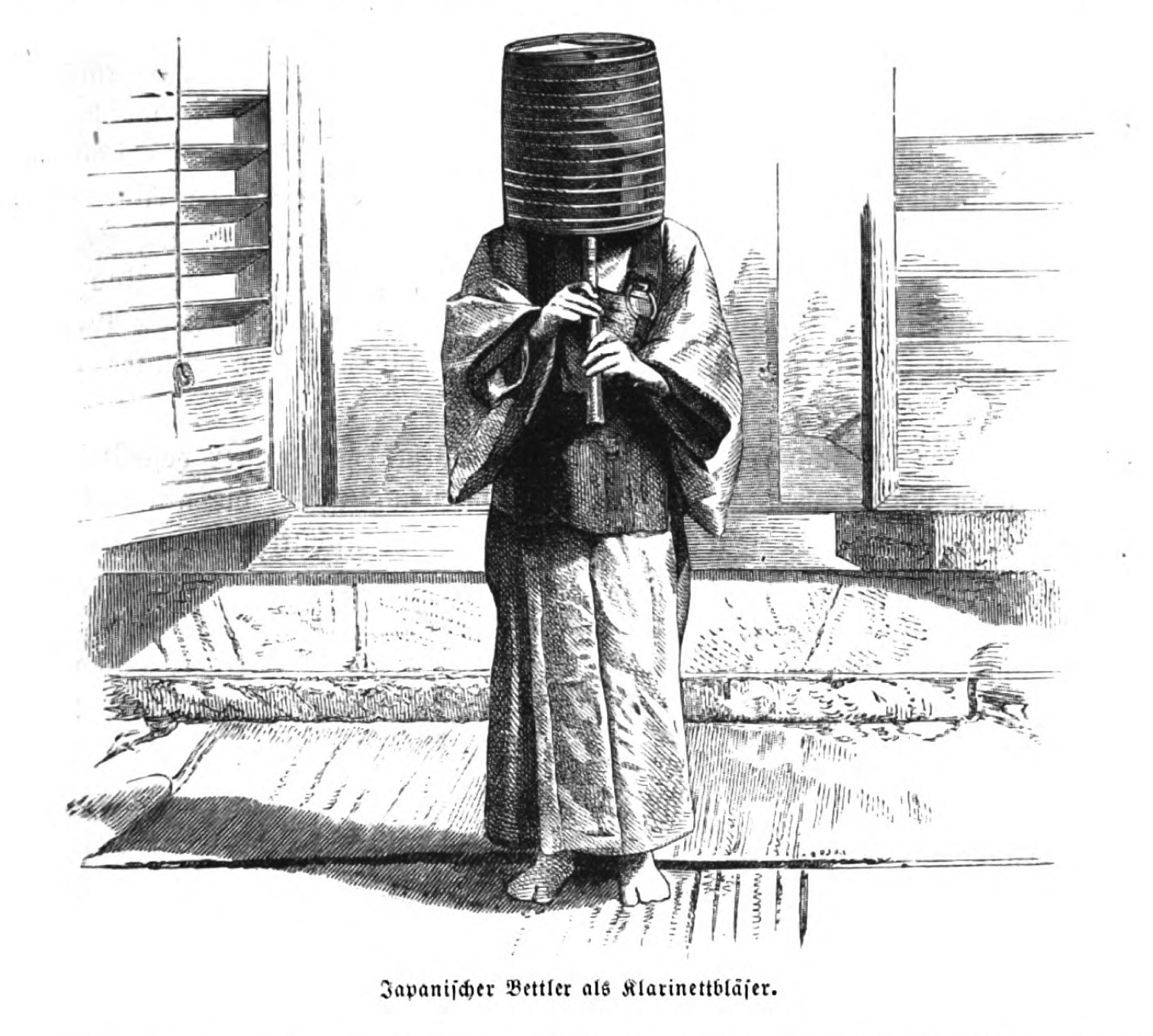
"Japanischer Bettler als Klarinettbläser"
"A Japanese Beggar as Clarinet Player"
'Komusō' in Gustav A. Spieß, 1864, page 201.
This is but the second oldest known Western picture of a performing shakuhachi-playing beggar lay pseudo-monk.
It was printed from an engraving based on an original photograph taken in 1861 somewhere in Nagasaki in SW Japan by either August Sachtler or John Wilson during the visit there of the official Prussian Expedition to Japan, 1860-61.
1867:
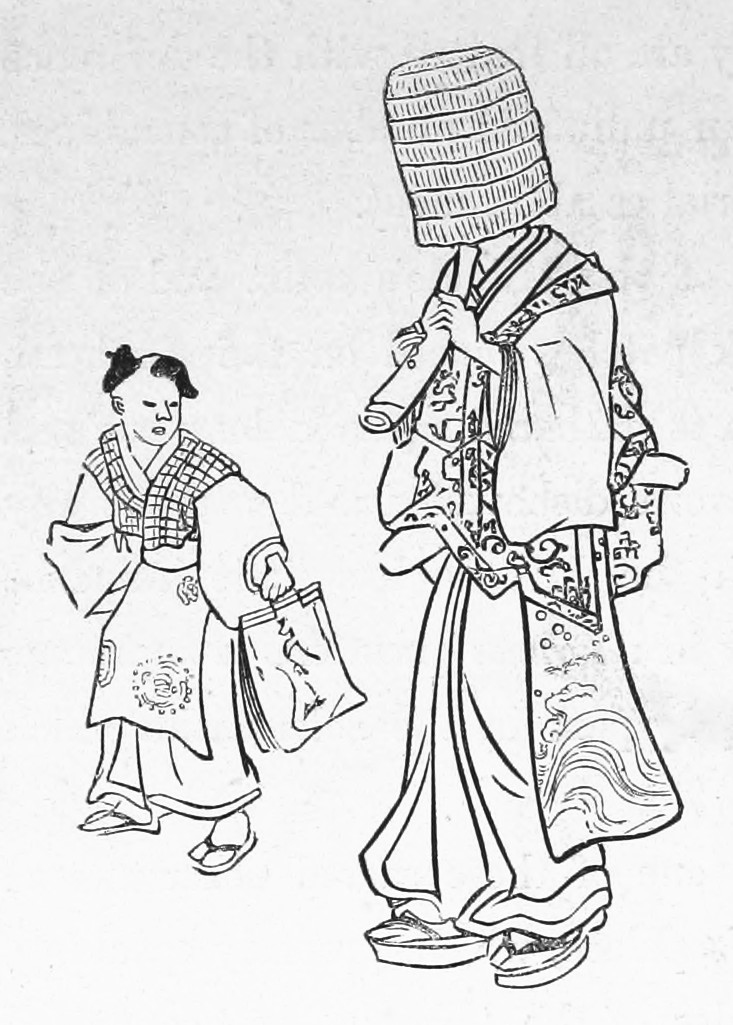
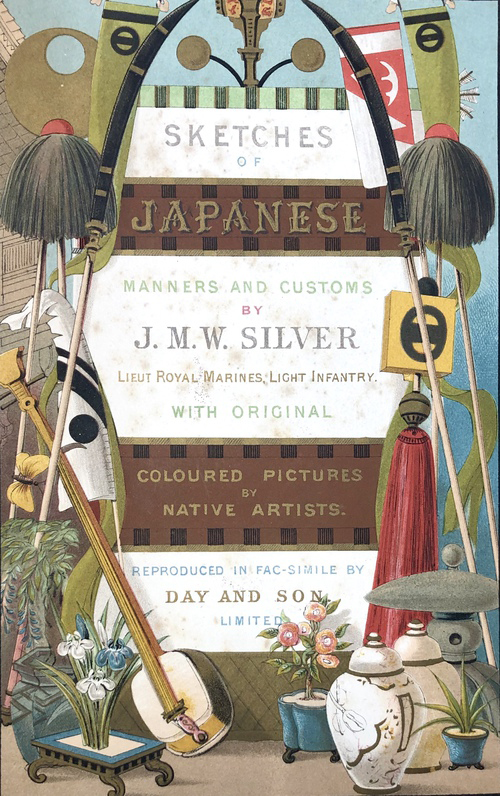
"A Begging Criminal"; Komusō" with assistant, wood-cut print pictured in Jacob Mortimer Wier Silver's 1867 book "Sketches of Japanese Manners and Customs.
Illustrated by Native Drawings, Reproduced in Fac-simile by Means of Chromo-lithography,
published in London in 1867."
J.M.W. Silver's amusing text that accompanies and describes the picture:
"The men whose features are concealed by their broad hats are 'Ninsokee,' or 'public singers.'
Generally speaking they belong to the aristocratic class, and are reduced to earn their livelihood
in this manner in consequence of some misdemeanour, on account of which their property
has been forfeited to the state.
Their occupation is in itself a punishment, as Japanese gentlemen never sing, regarding that accomplishment as derogatory to their dignity.
A certain class of criminals also wear a disguise of this nature, as shown in the woodcut."
Links: https://garystockbridge617.getarchive.net/amp/topics/j+m+w+silver+sketches+of+japanese+manners+and+customs
https://www.gutenberg.org/ebooks/13051
Kindle version on Amazon.com:
https://p-yo-www-amazon-in-kalias.amazon.in/Sketches-Japanese-Manners-Customs-Silver/dp/1015646123
Late 1860s:
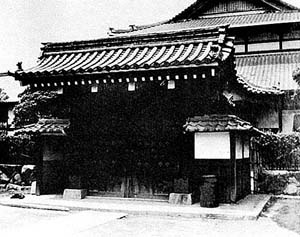
Gate of the former Edo Period Myōan-ji in Eastern Kyōto
Source: Tomimori, 1979.
With the abolition of the so called Fuke Sect of the komusō in late November, 1871 (Meiji 4),
all of its temples were closed and komusō mendicancy was prohibited.
Myōan-ji's precious statue of its legendary (!) founder 'Kyochiku Ryōen Zenji' was, allegedly, together with various especially important Myōan-ji documents, entrusted to the Zen'ei'in, a small subtemple of the grand Tōfuku Zen temple in SE Kyōto.
Early 1870s:
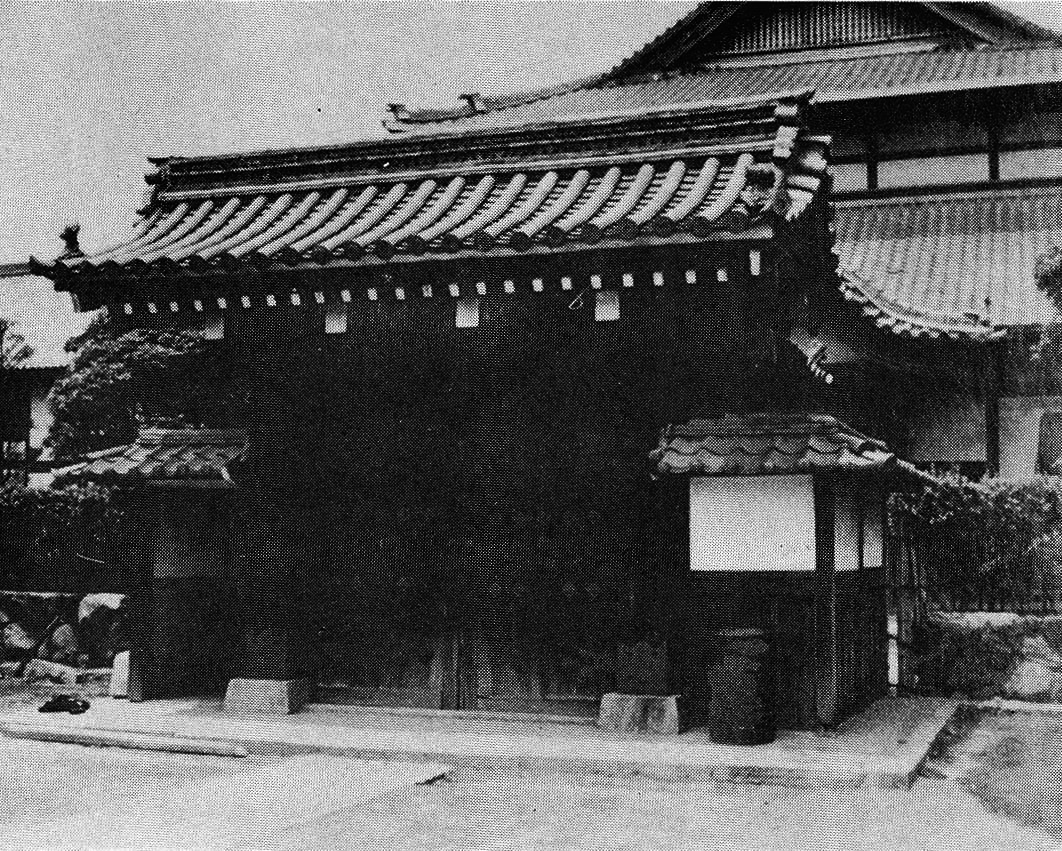
Gate of the former Myōan-ji at Kitashirakawa Shimo-Ikeda-chō in Eastern Kyōto
In: Tomimori, 1979
THE MOVE
With the abolition of the "Fuke Sect" in late November, 1871 (Meiji 4),
all of its "temples" and haunts were ordered to be closed, the premises be sold off, while 'Komusō' mendicancy was prohibited.
Acc. to Kanagawa resident shakuhachi player Maekawa Kōgetsu, 前川耕月, updating his weblog in late April, 2018, the old Myōan-ji main gate was first disassembled and moved to an elementary school in central Kyōto to be reassembled there.
Now, the old, worn Myōan-ji gate can be seen and appreciated within the precincts of the Yūzū Nenbutsu sect's mother temple Dainenbutsu-ji, 大念仏寺, in Hirano-ku, Ōsaka:
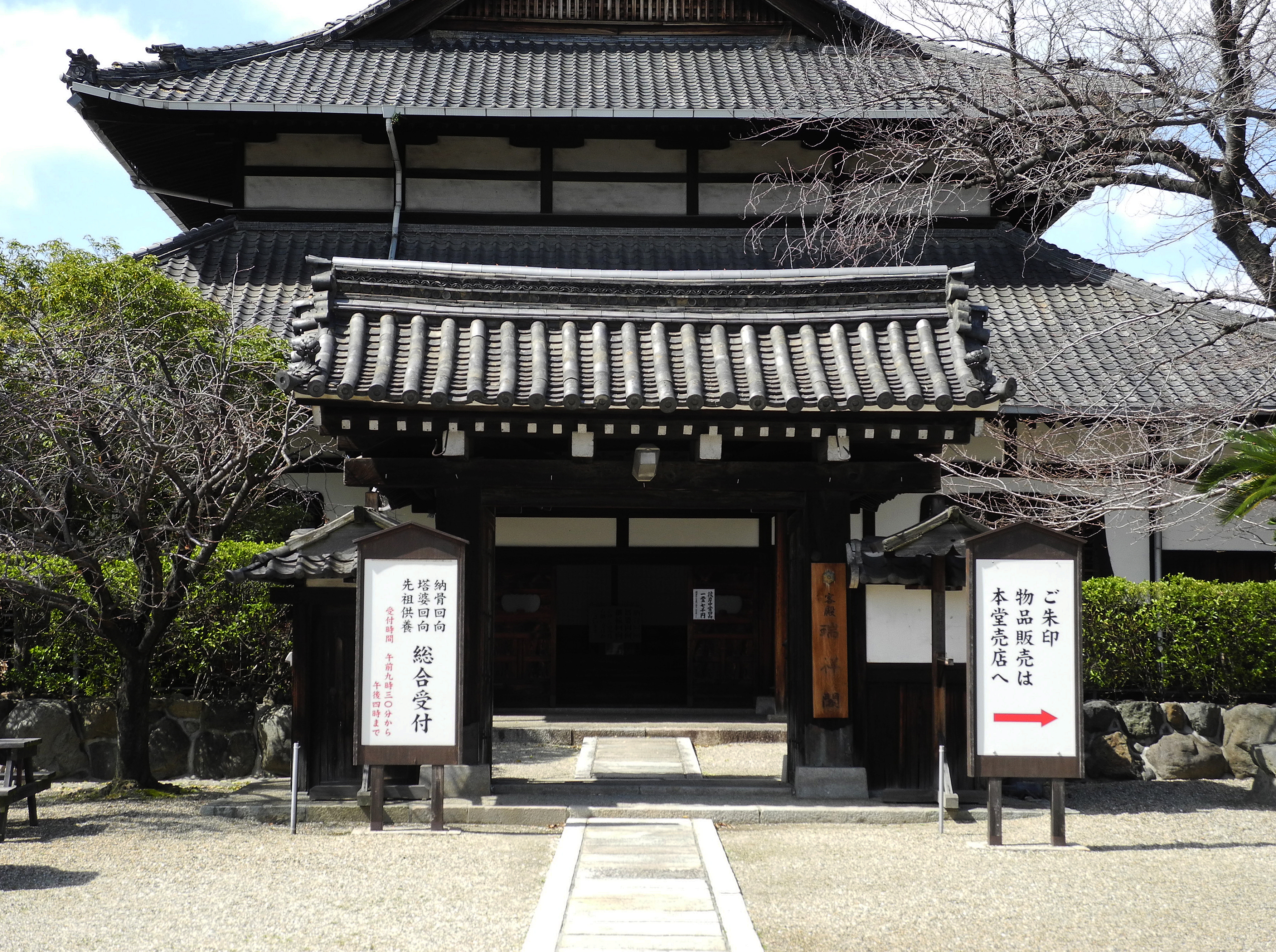
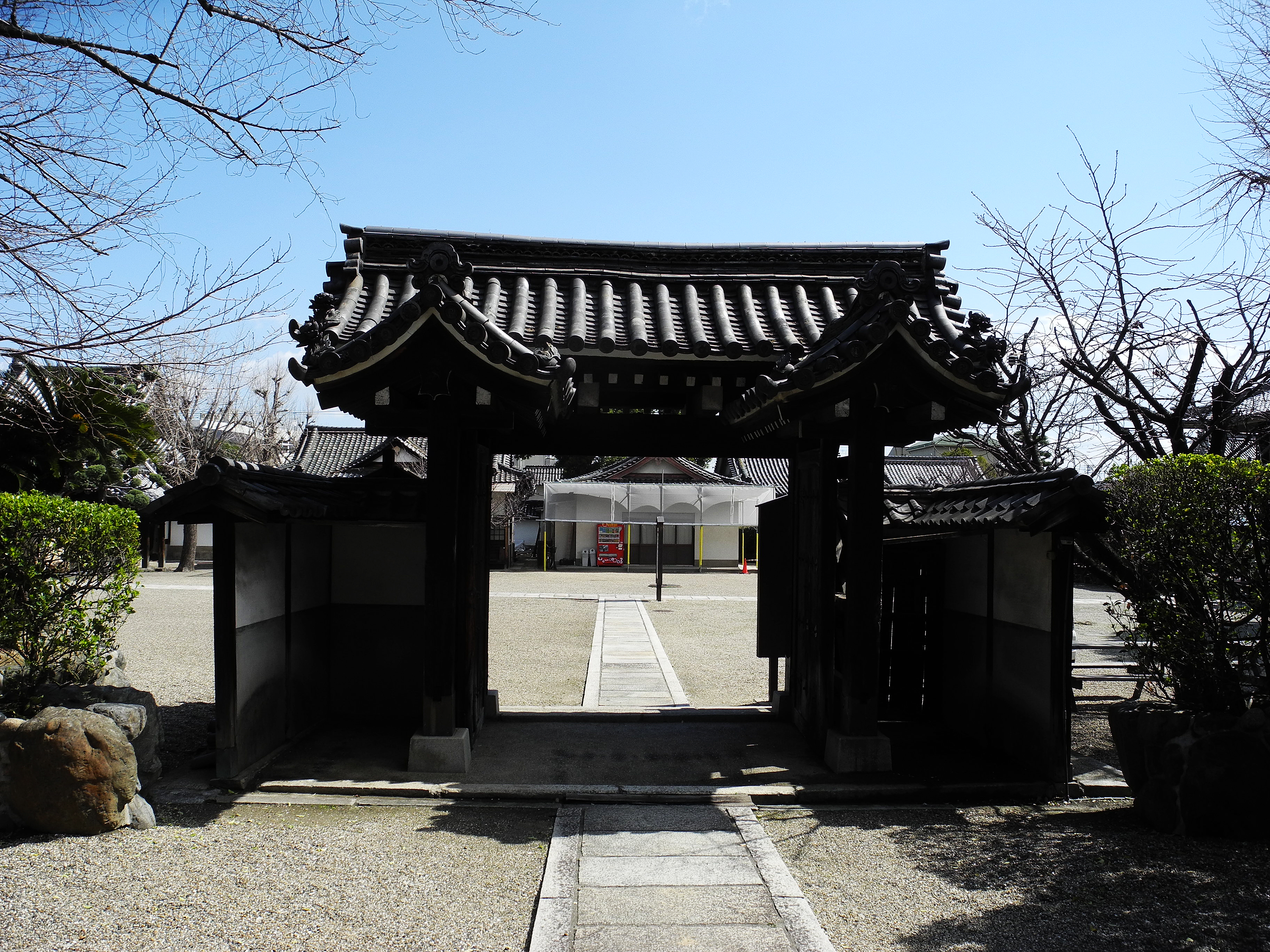
The old Myōan-ji gate reinstalled at Dainenbutsu-ji in Hirano-ku, Ōsaka.
Photos: T.O., 2019
1890:
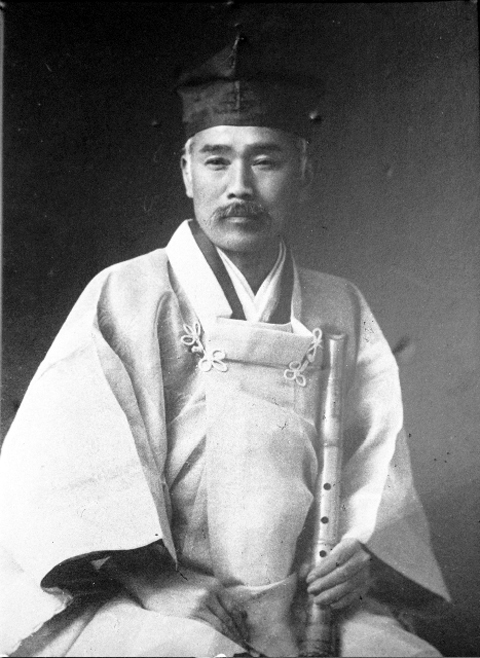
Higuchi Taizan - 1856-1914
Founded the Myōan Kyōkai and the Myōan Taizan-ha tradition of ascetic shakuhachi practice in 1890.
Time and photographer unknown.
1903:
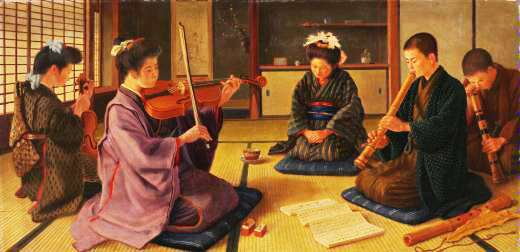
Oil painting by Sakaki Teitoku, 1858-1939: "Concert by Japanese and Western Instruments"
Nagasaki Prefectural Art Museum, Japan
After 1890: Early 1900s? - Early modern Myōan kyōkai 'Komusō'
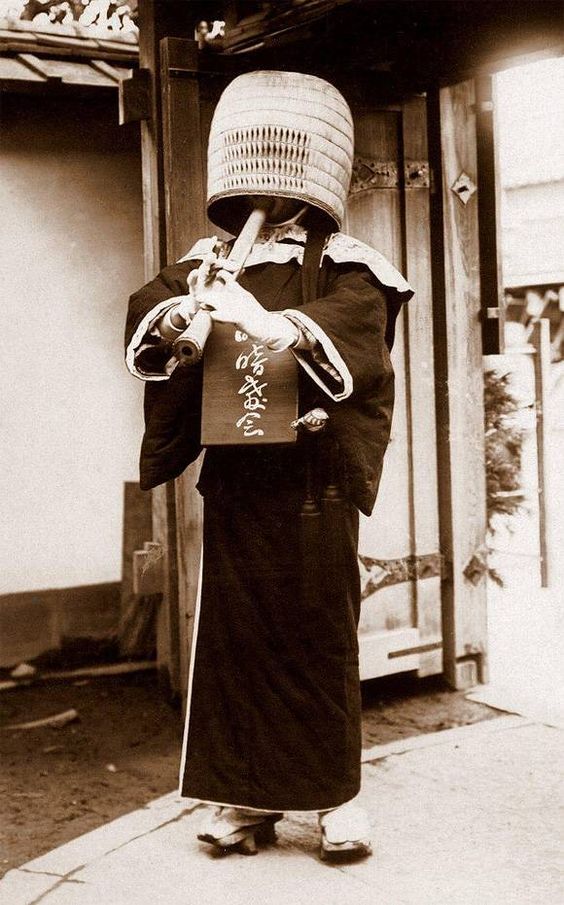
Myōan kyōkai 'Komusō', early 1900s?
Name of photographer unknown.
Source: pinterest.com
1904:
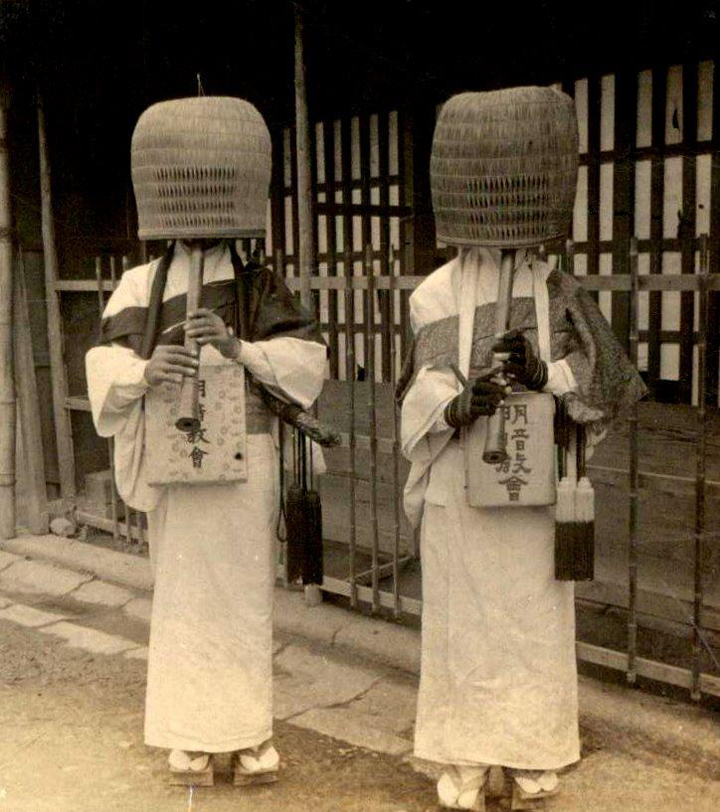
Myōan kyōkai 'Komusō', 1904
Photo by Julian Cochrane.
Source: pinterest.com
1924-1927:
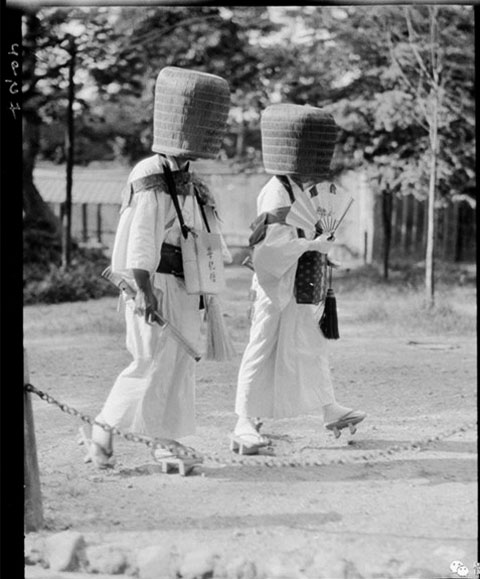
Kyōto 'Komusō'
Name of photographer unknown.
Source: https://hznews.hangzhou.com.cn/wghz/content/2019-10/11/content_7282303_0.htm
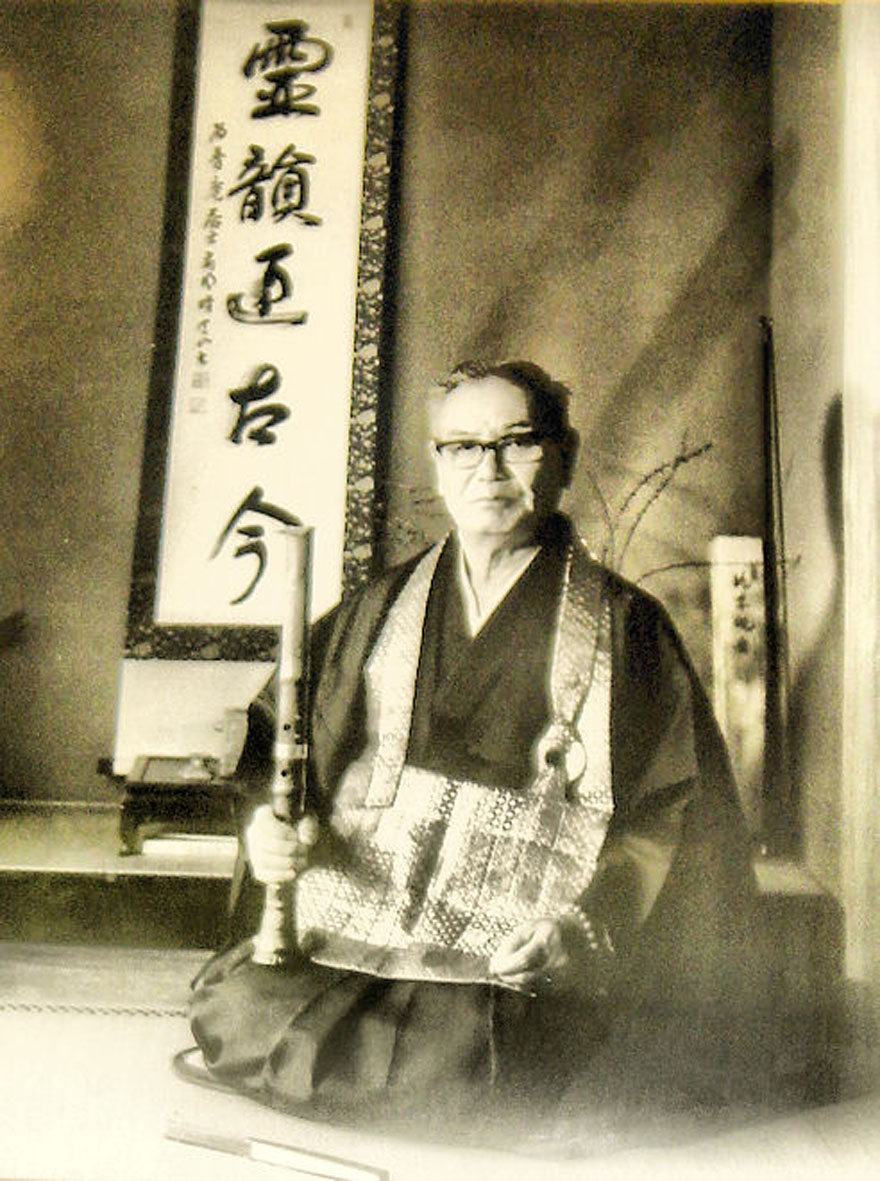
Yoshimura Fuan Sōshin - 1904-1998
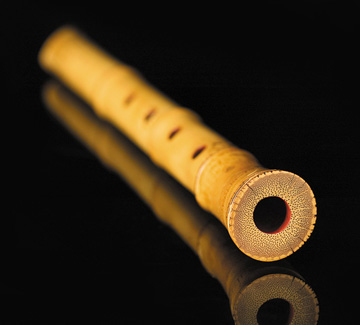
1.8 foot Myōan Taizan-ha shakuhachi made by Ozawa Seizan
not later than early 1978. Photo by Christoffer Askman
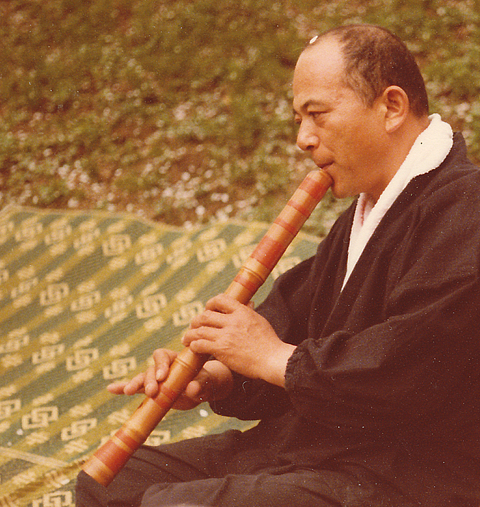
Ozawa Seizan sensei, 1939-2012 - Spring 1978.
Photo: T.O.

'MU-KU-TEKI SUI-ZEN'
"No Hole Flute - Blowing a Flute Non-dualistic Contemplation Practice"
Calligraphy signed 'Myōan Taizan', the 2nd present times
Myōan Temple chief monk Hirazumi Taizan, 平住台山, (a.k.a. Myōan Taizan),
inaugurated in 1952, died in 1984 (Shōwa 59).
Signature and stamps deciphered by Kosuge Daisetsu (Komusō kenkyūkai/Hosshin-ji),
and Sato Nakazato, Japan. A present to Torsten Olafsson
given by his teacher Ozawa Seizan in the early Summer of 1978
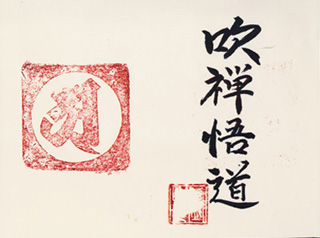
Opening pages of a honkyoku folding book (ori-hon)
written by Matsumoto Kyozan, 松本虚三, dated 1985.
To the right: 'Suizen godō':
'Suizen Way of Buddhist Enlightenment'.
To the left the Sanskrit seed syllable 'A' (Jap.: 'A')
of the Buddha Mahāvairocana, or
Dainichi Nyorai, who resides in the center of the
Taizō-kai (Womb Realm) mandala (Skt.: Garbhadātu)
of Japanese Tantric Buddhism (Shingon).
© T.O.
See also:
Historical Shakuhachi Images Part 1 - till around 1640:
A Pictorial Chronology of Known Fine Historical
Illustrations of so called 'Shakuhachi' Flutes,
Its Many Players Throughout The Times,
with Additional Shakuhachi History Related Images
| To the front page | To the top |

Momiji